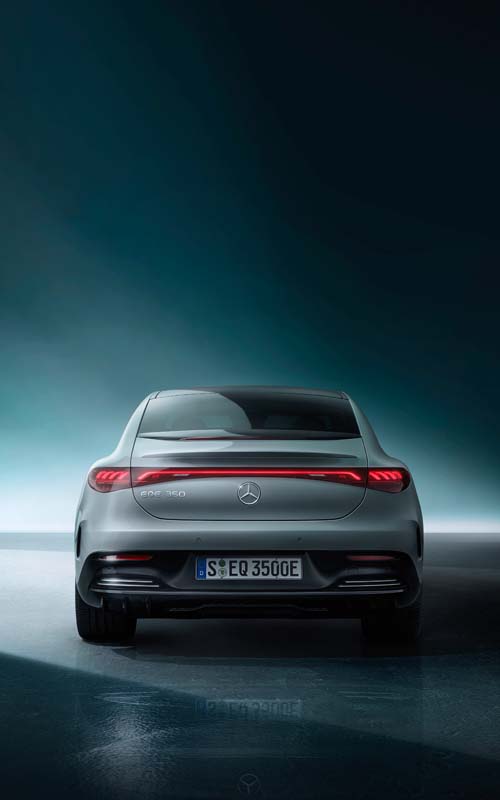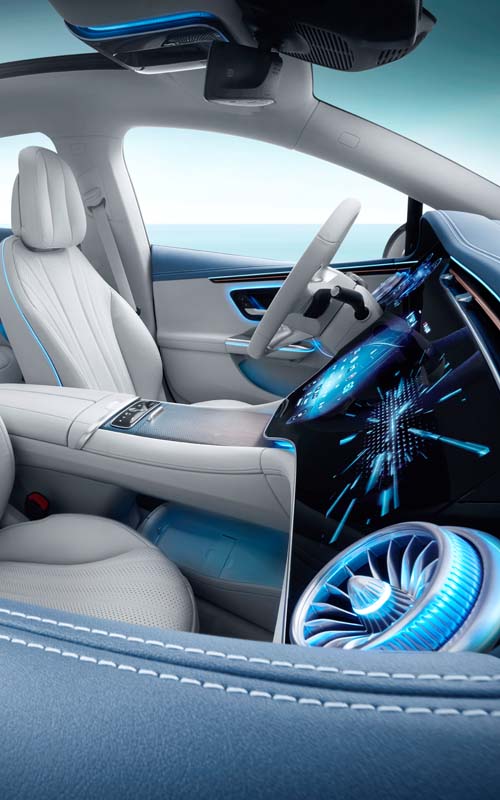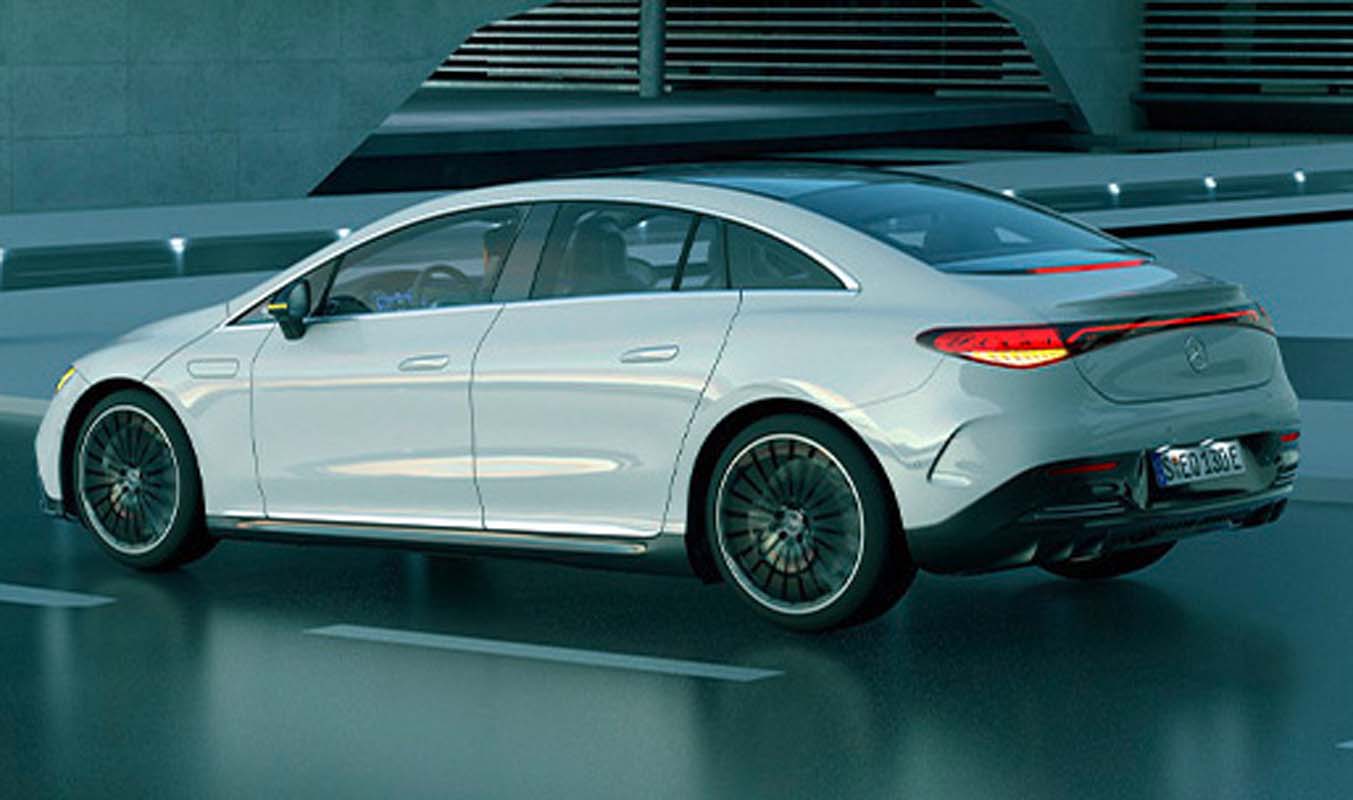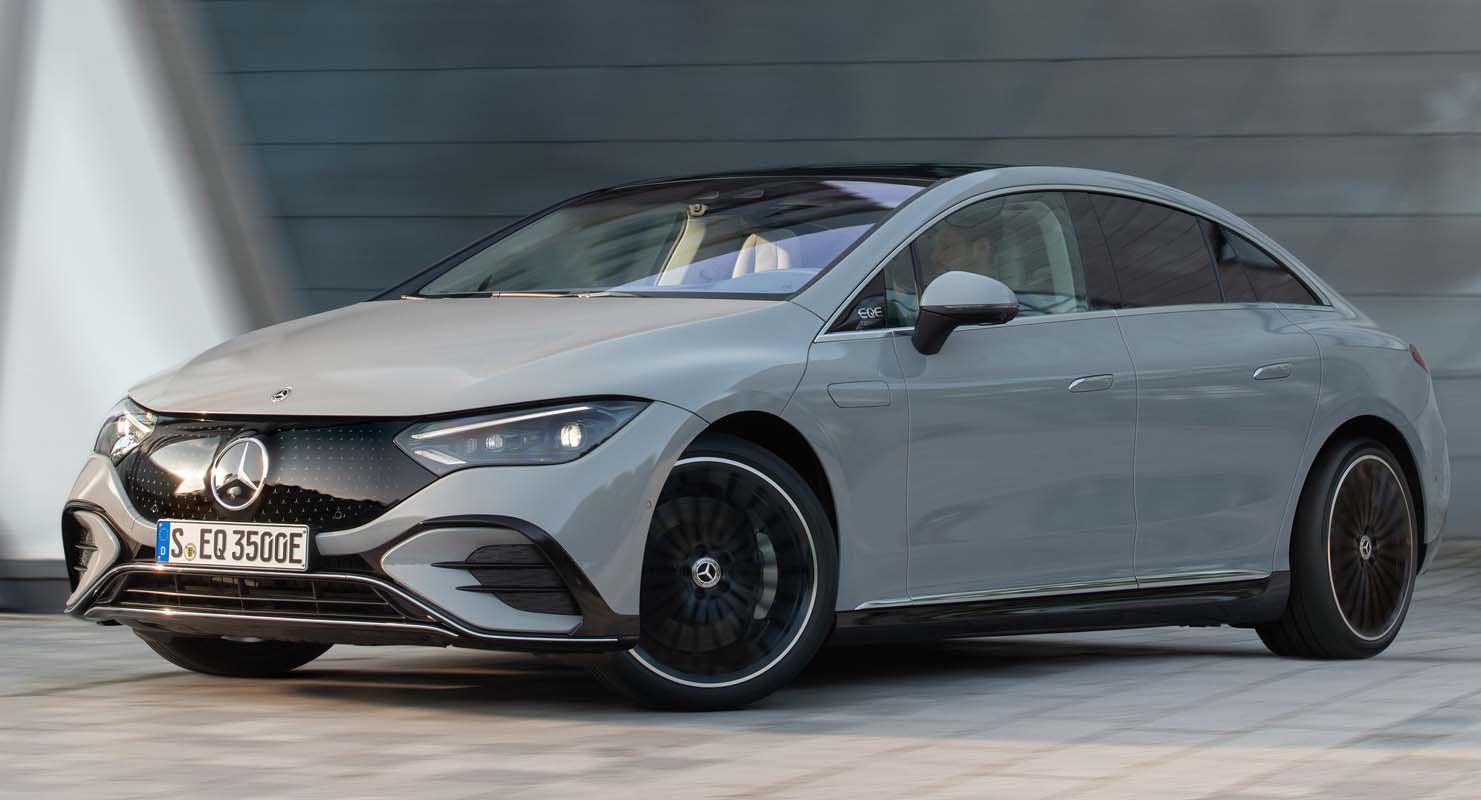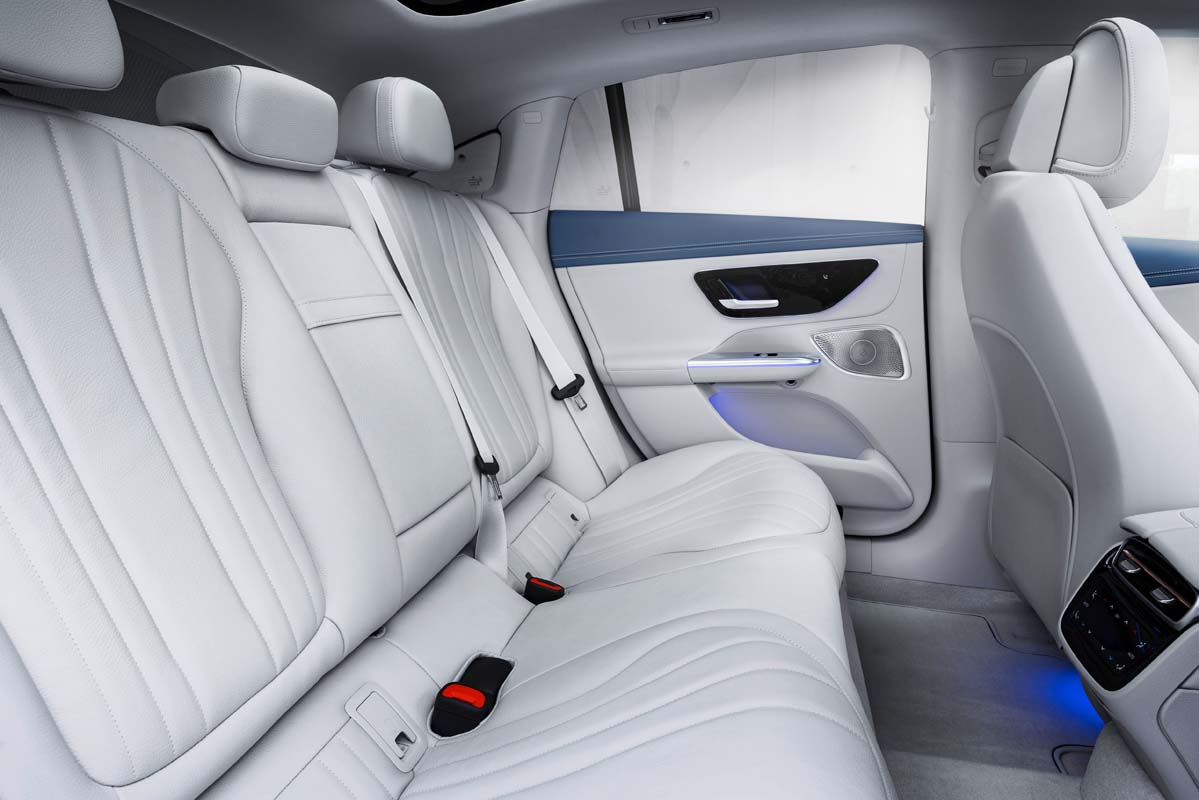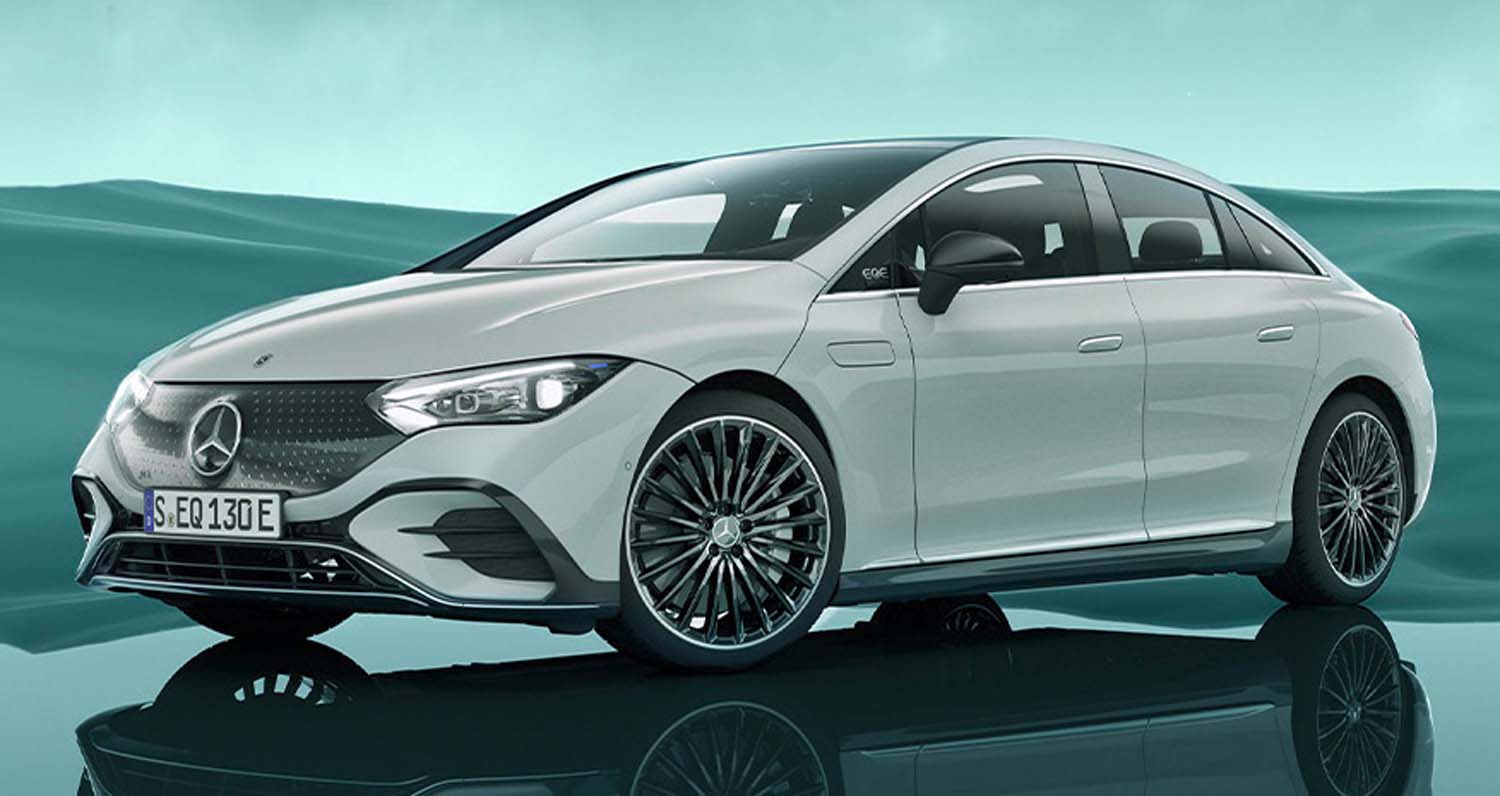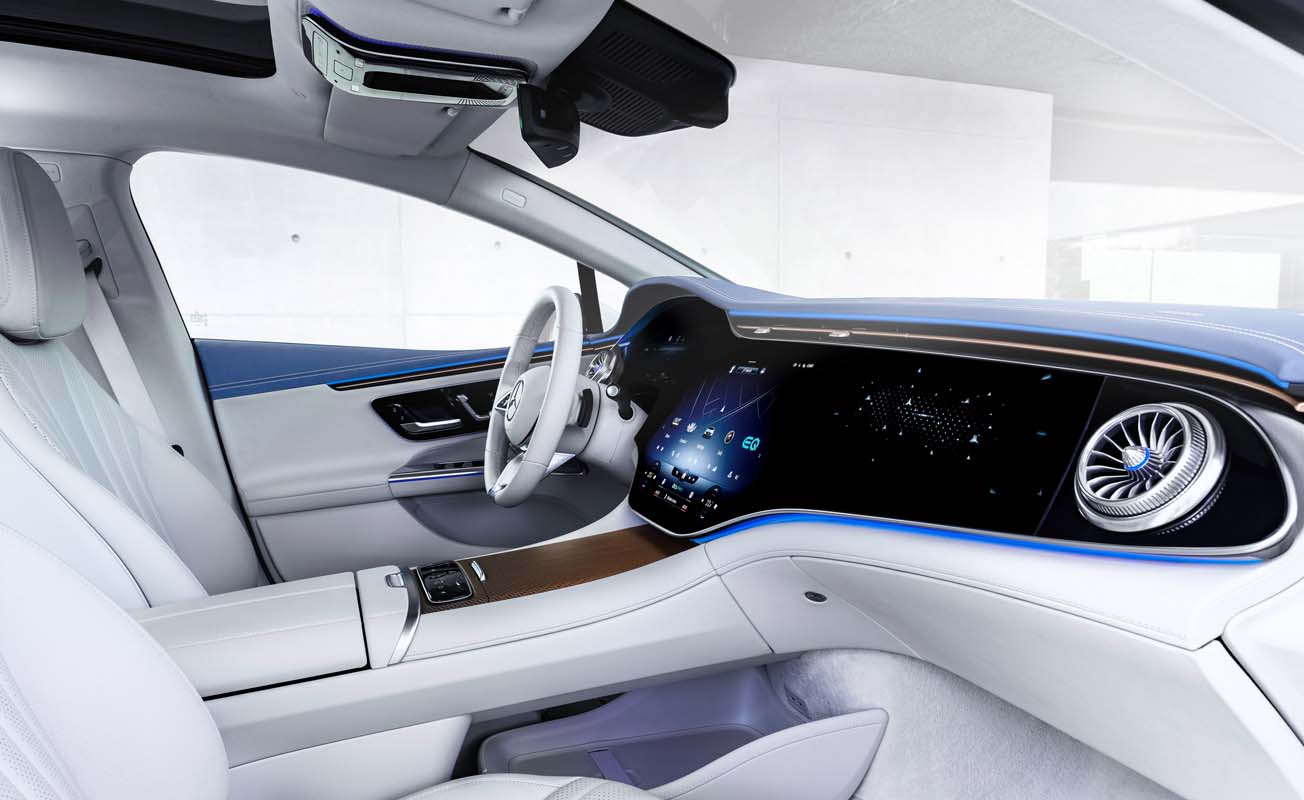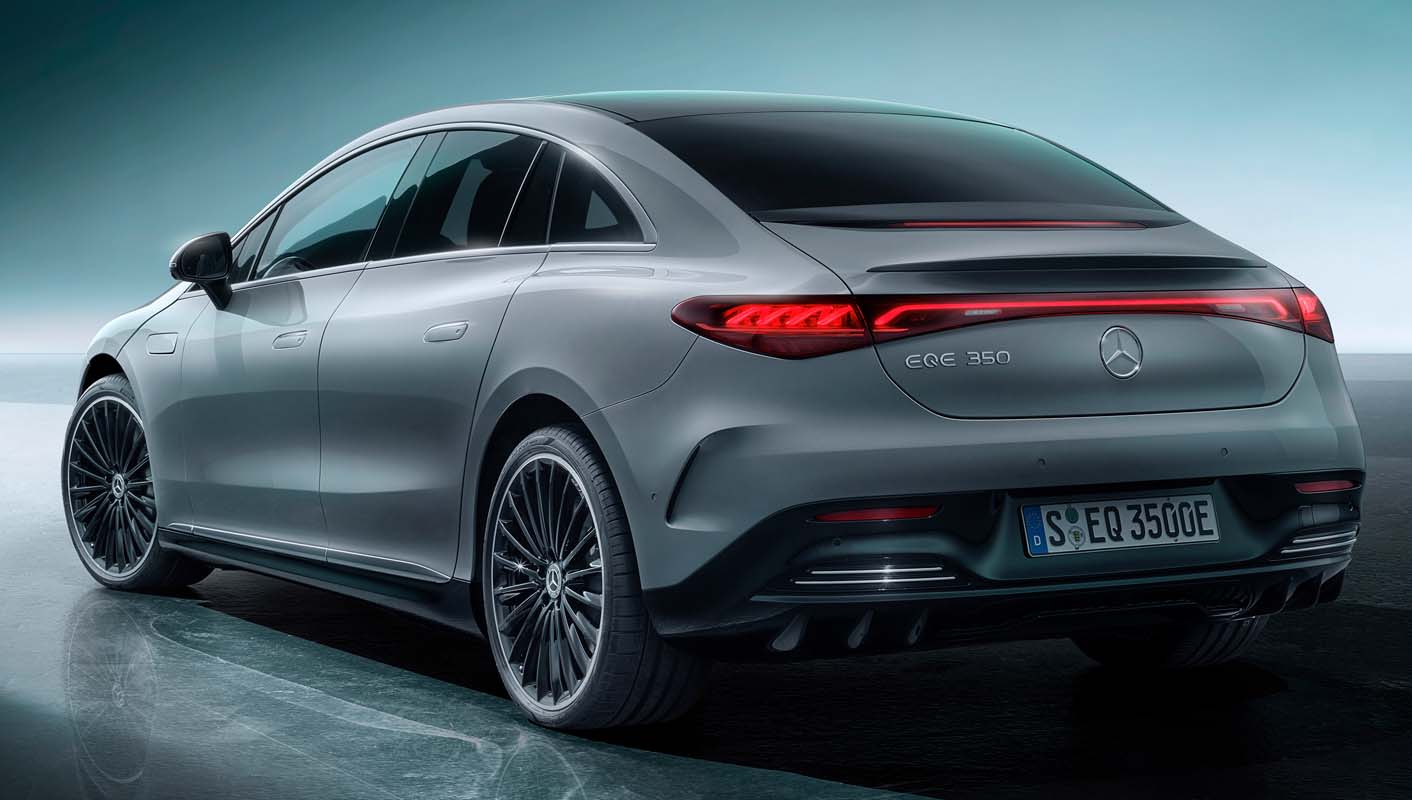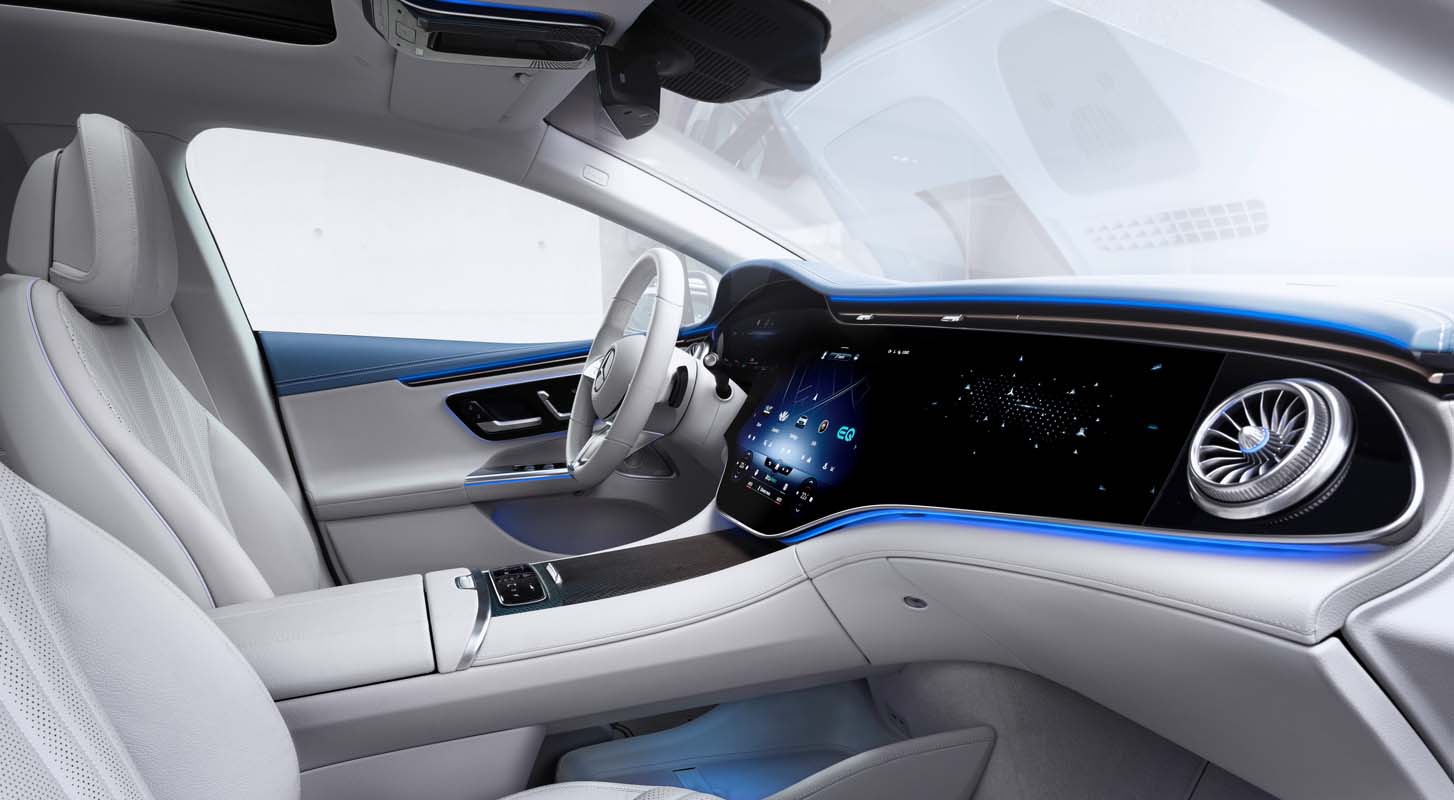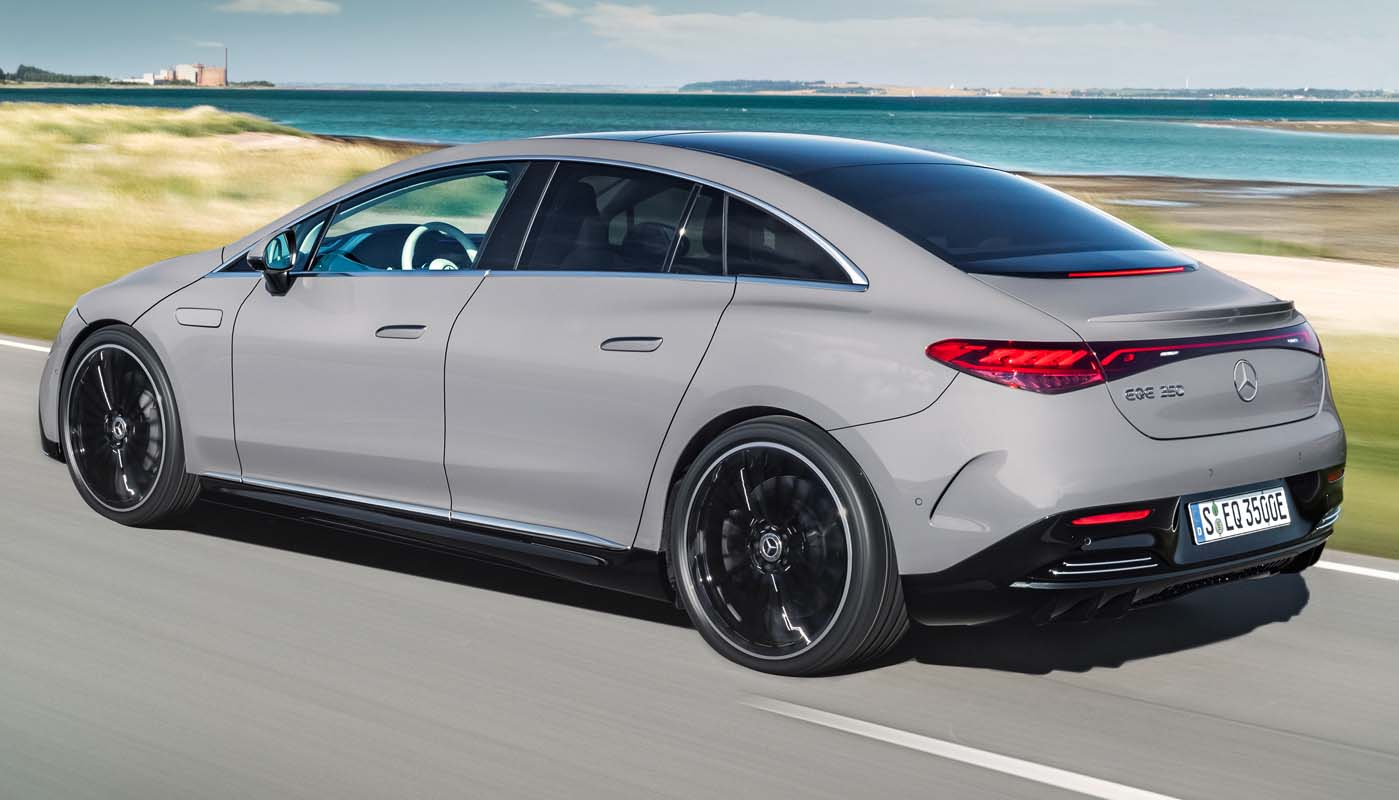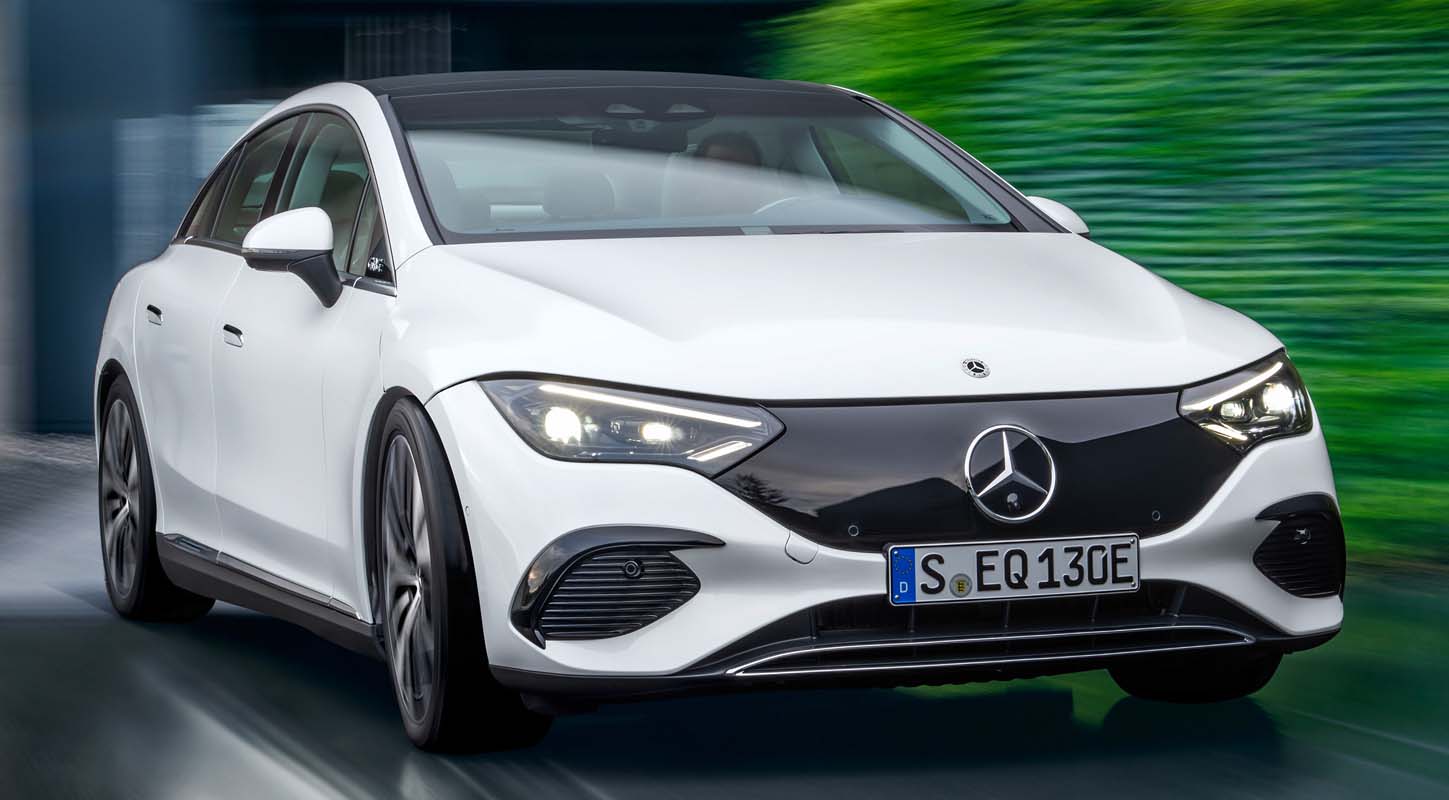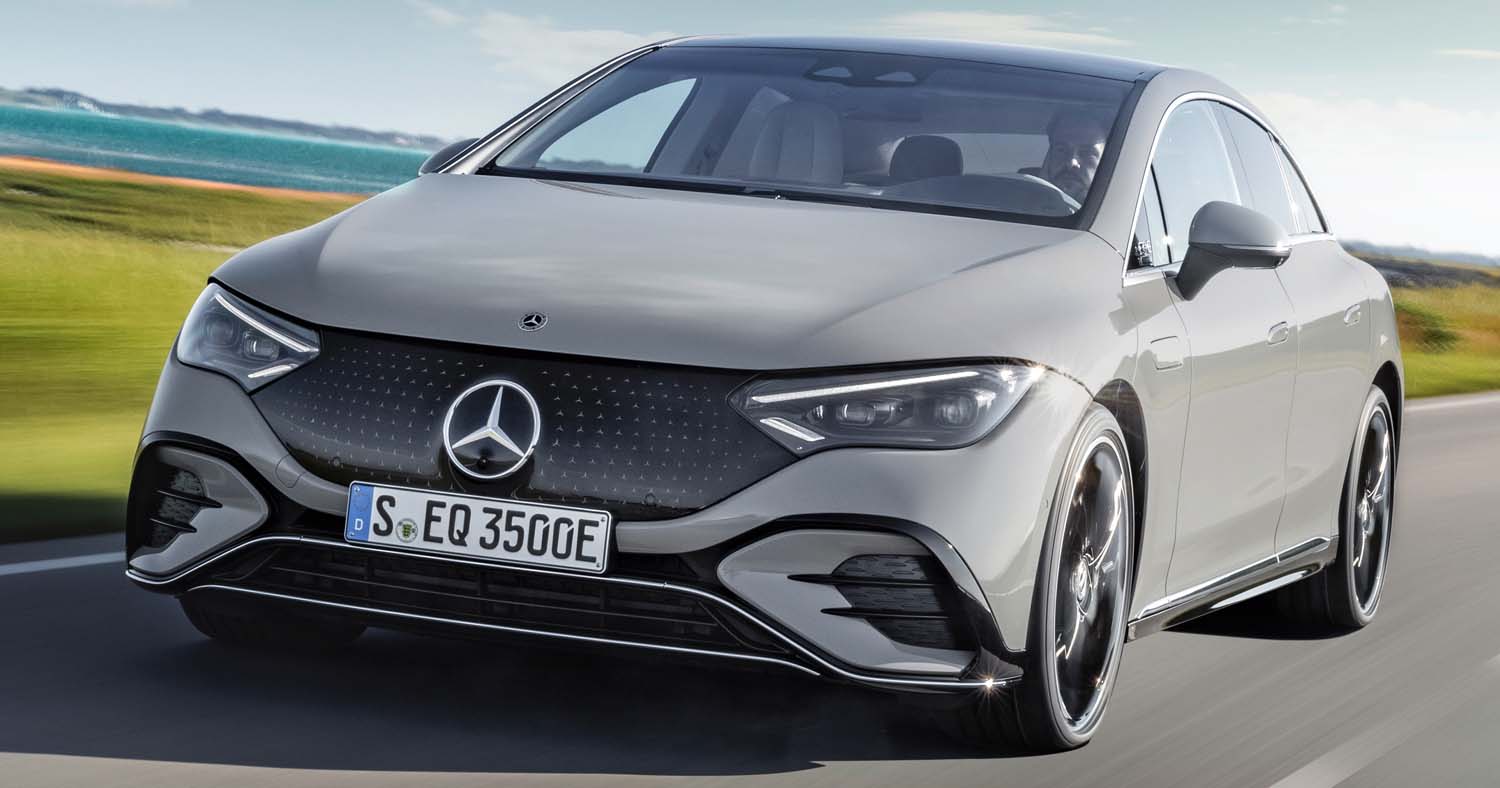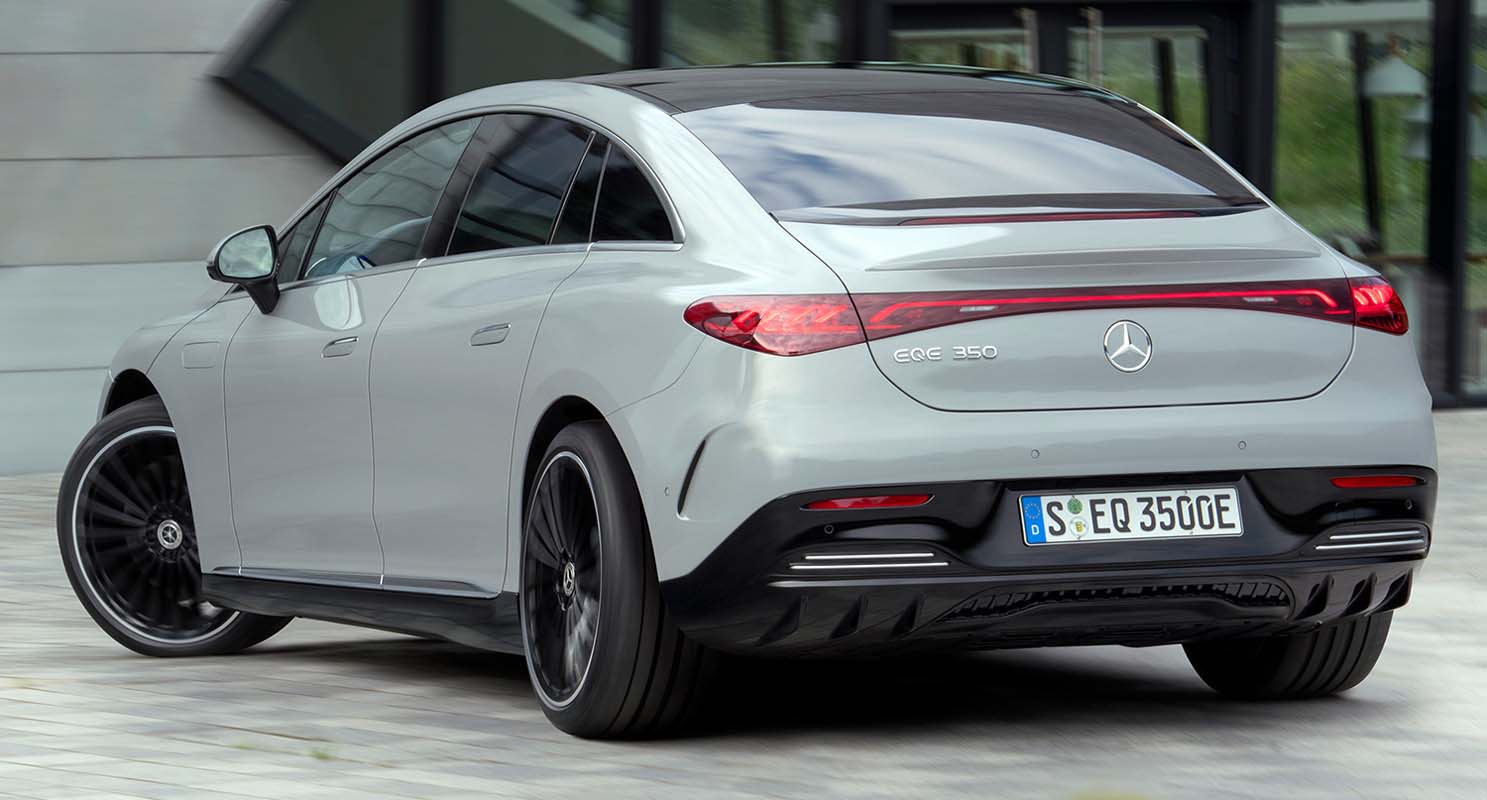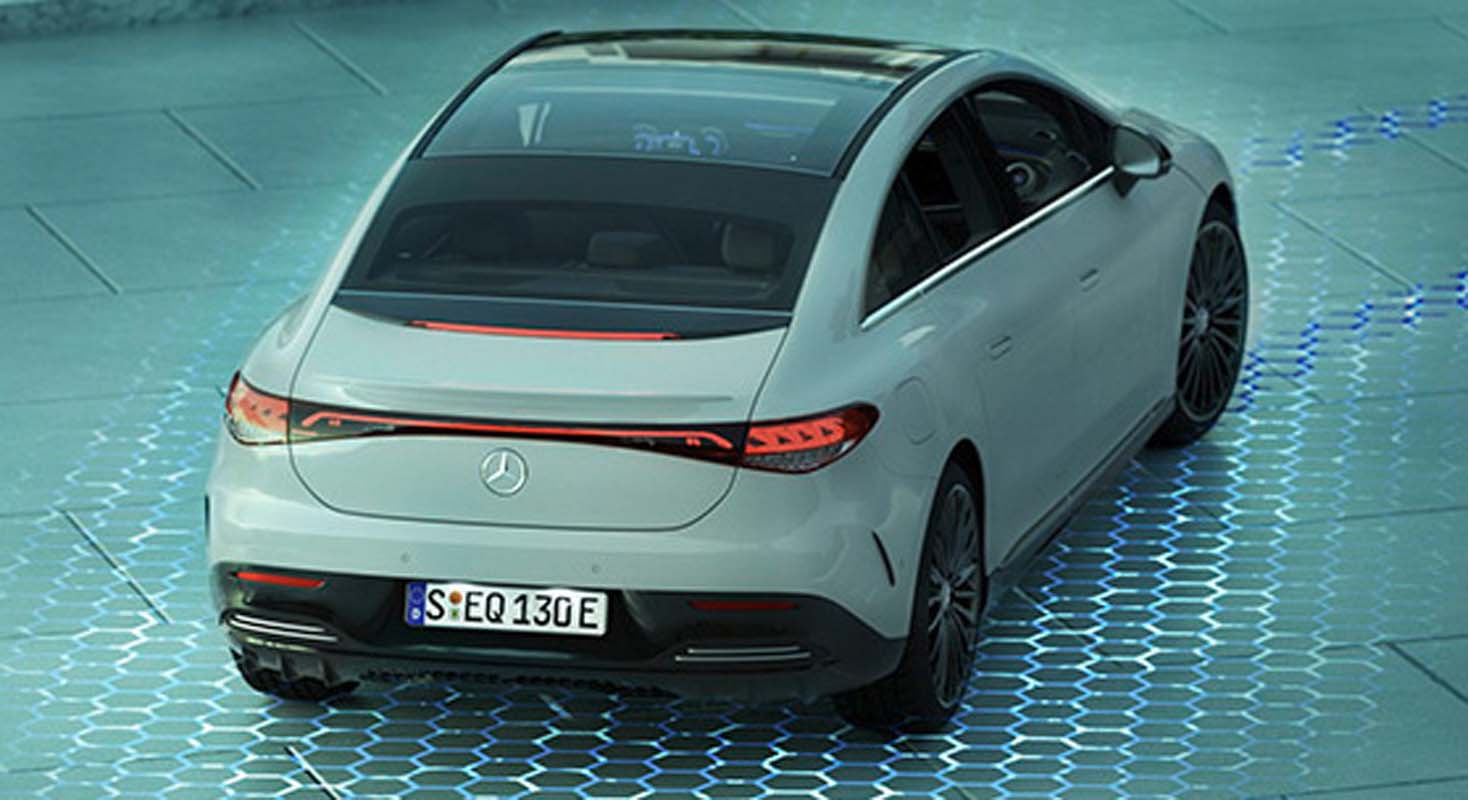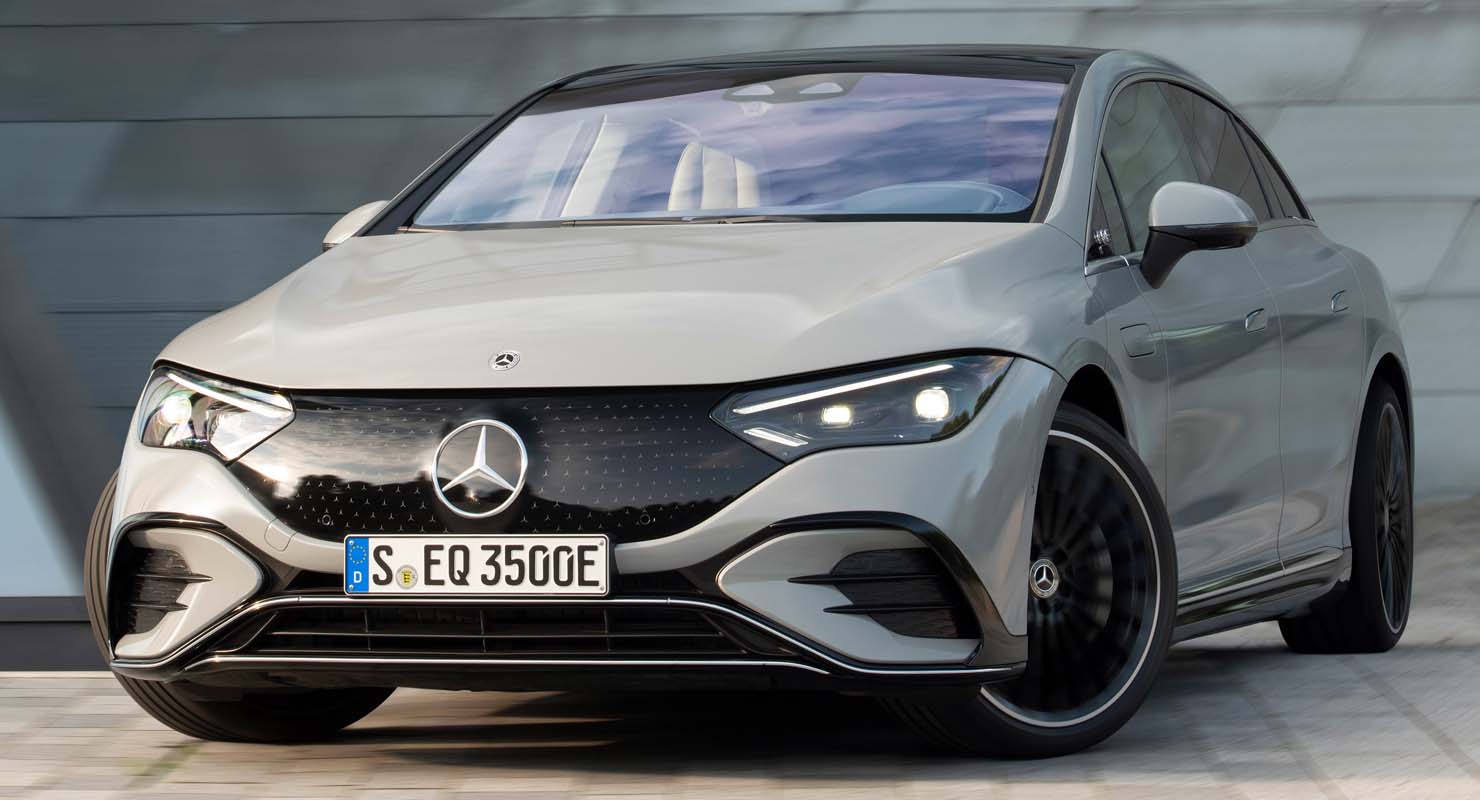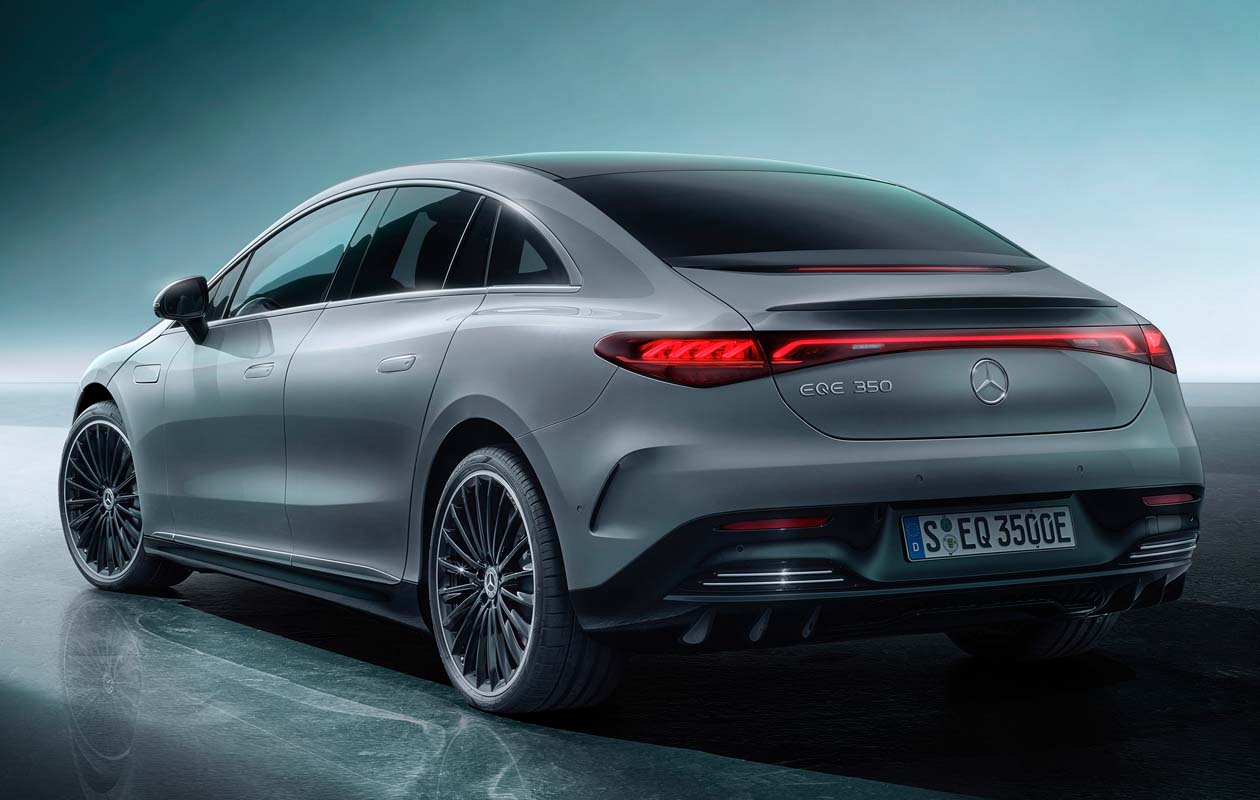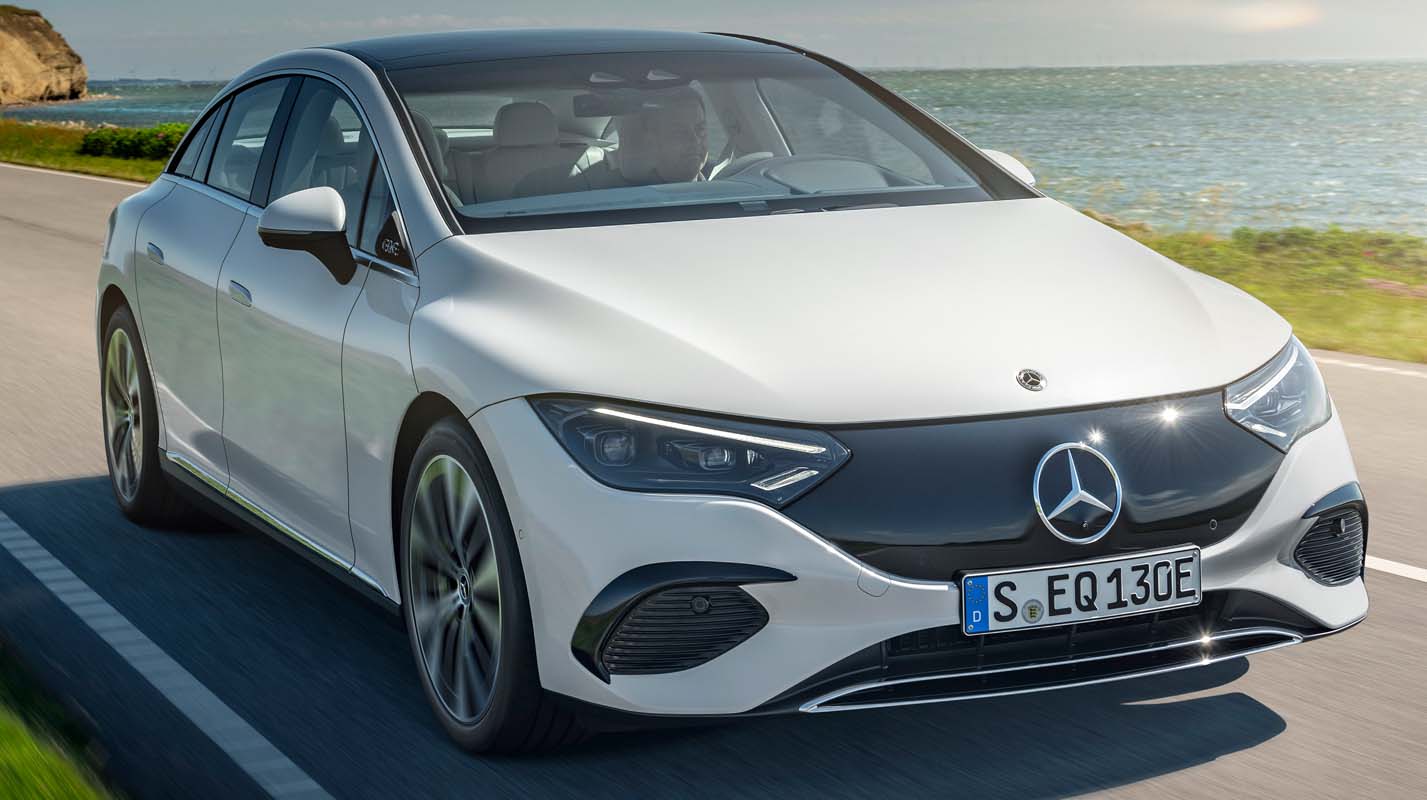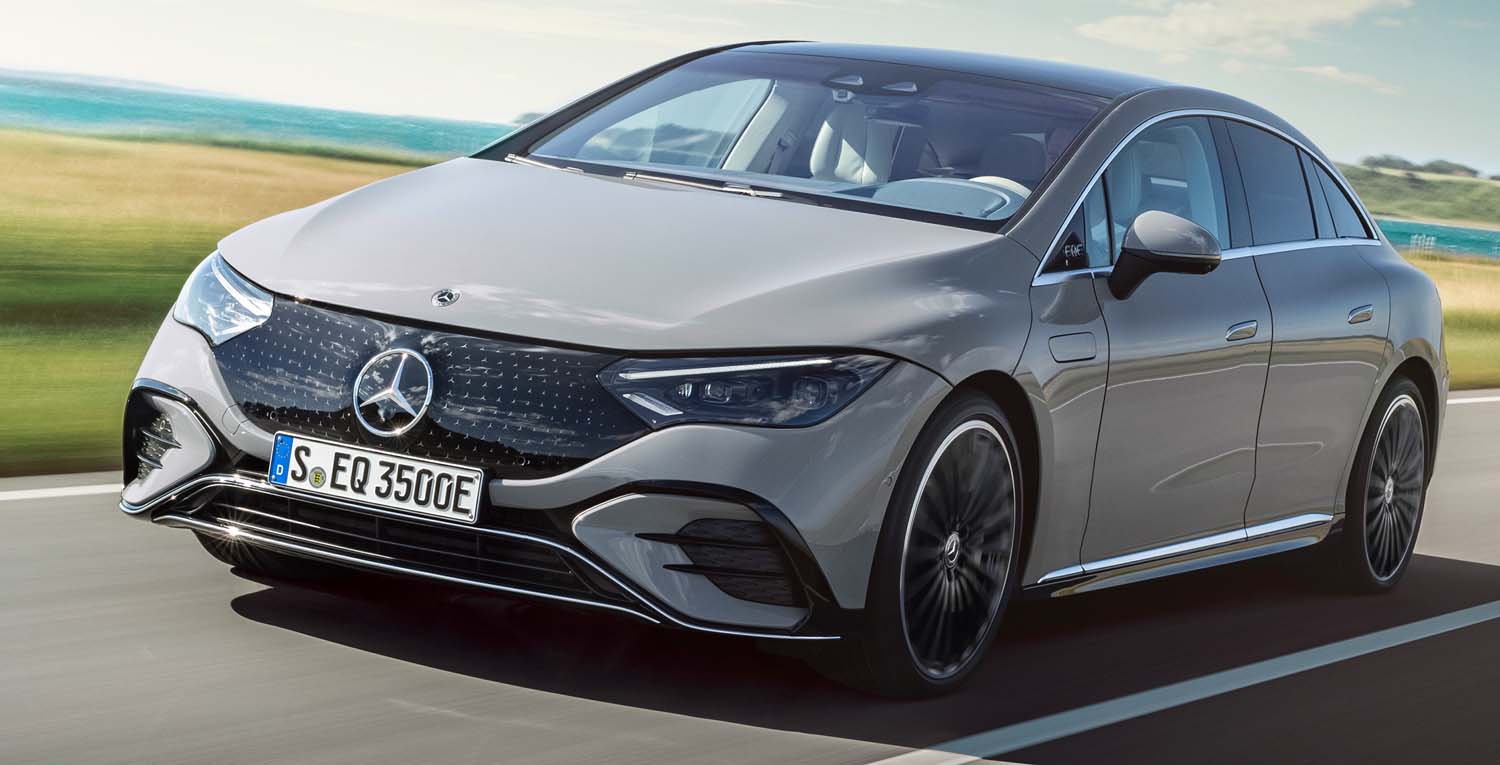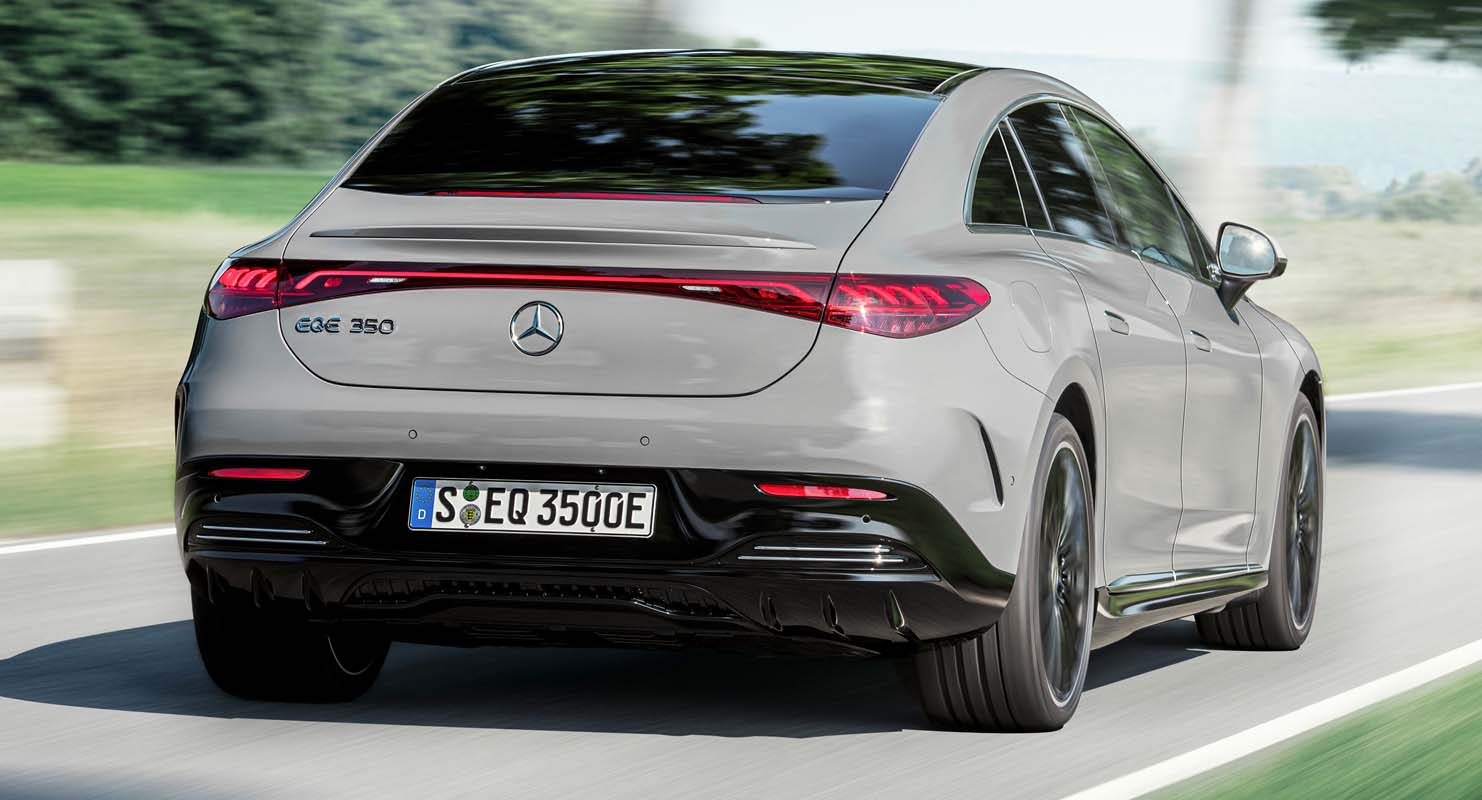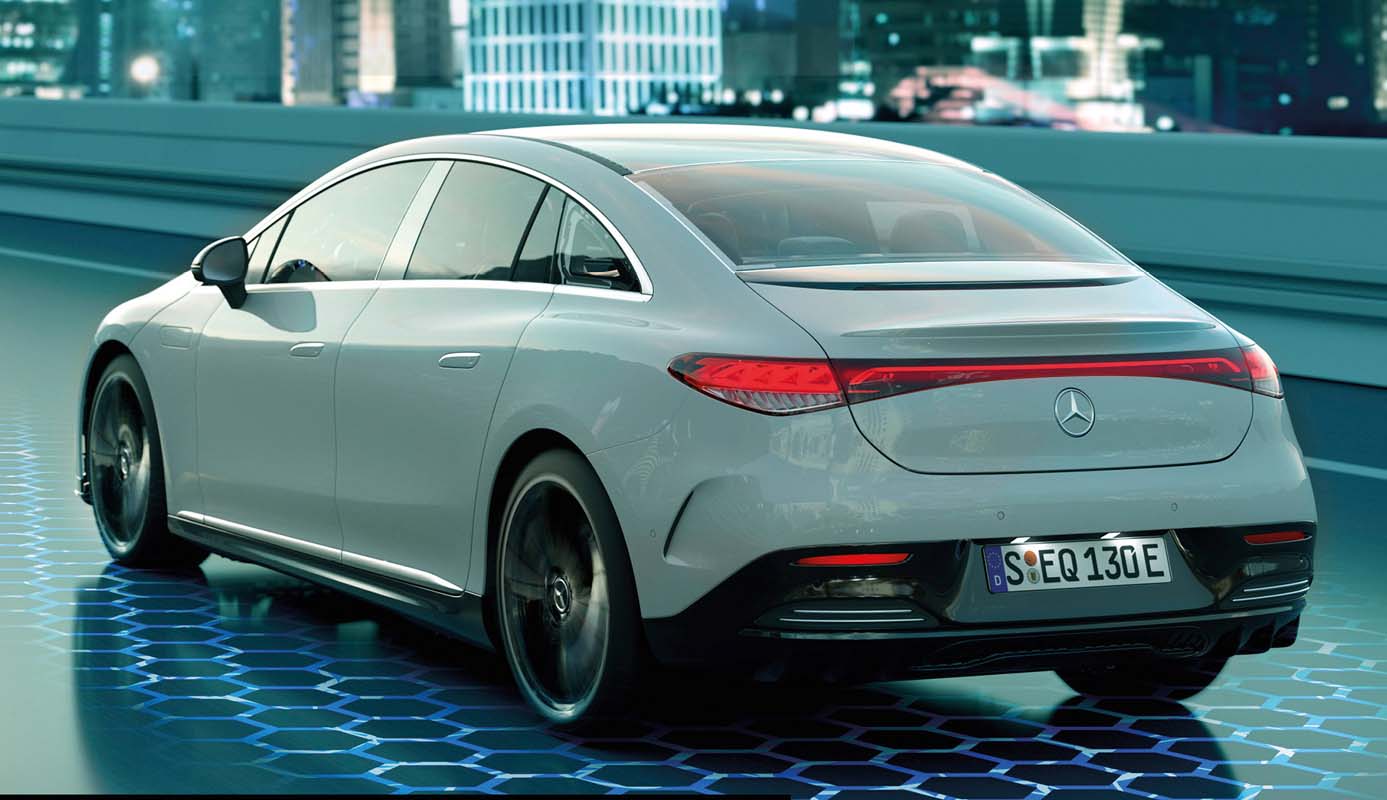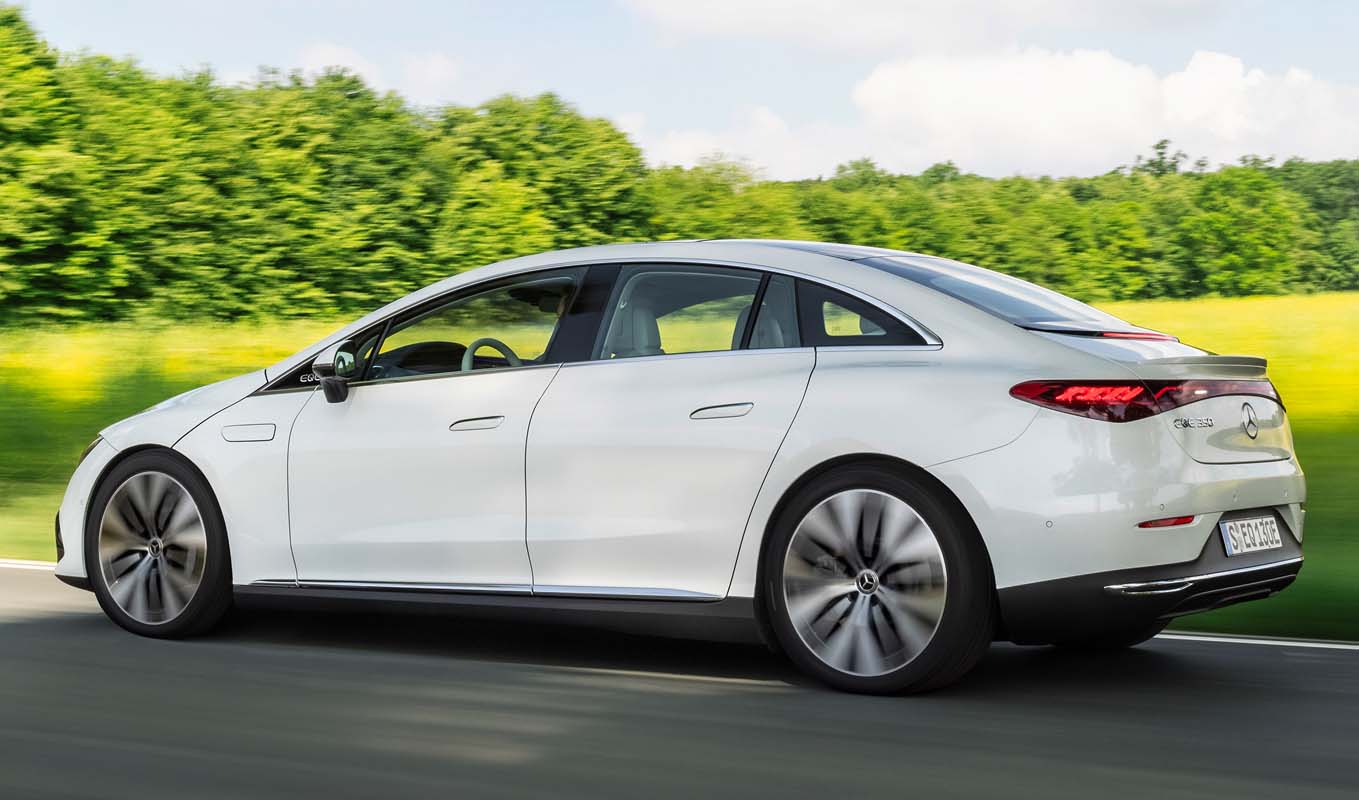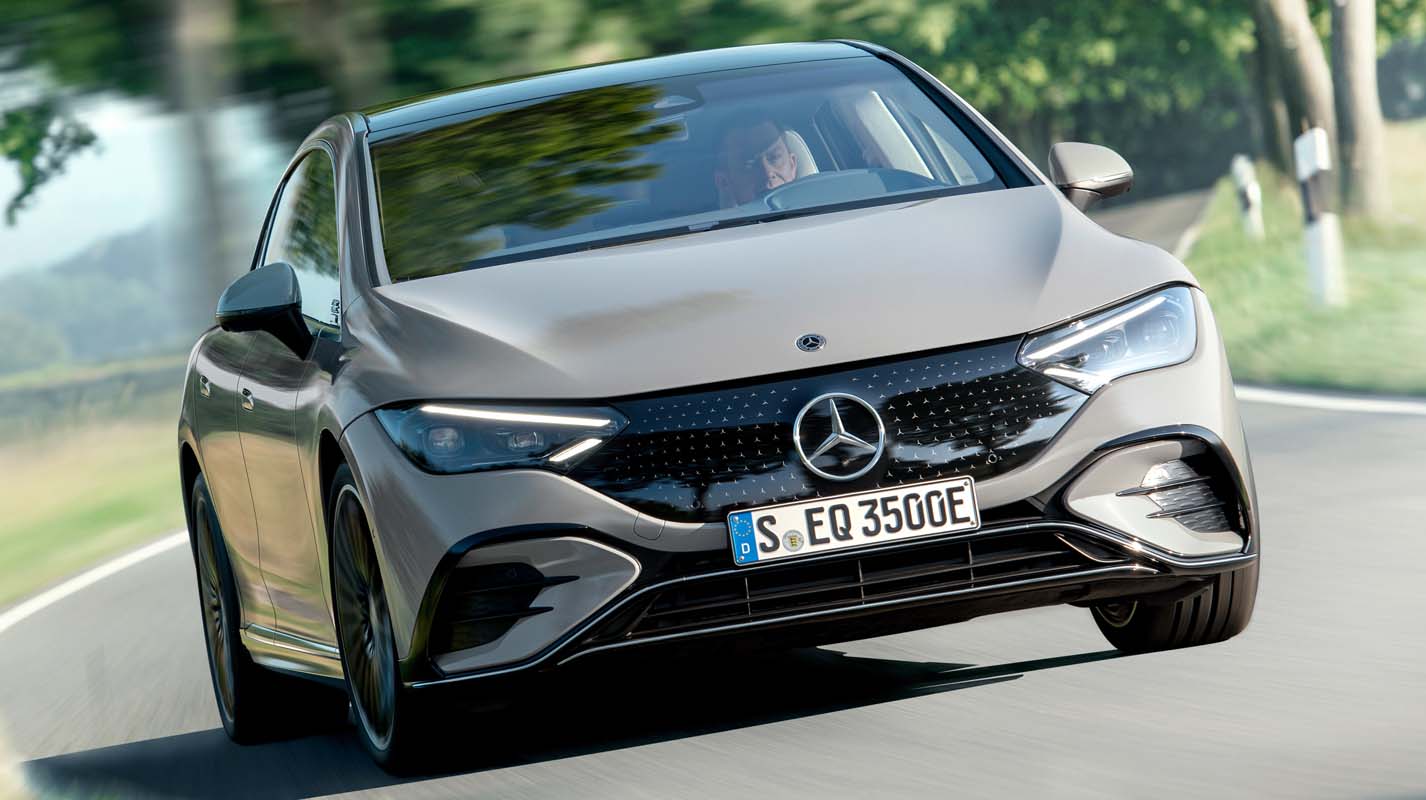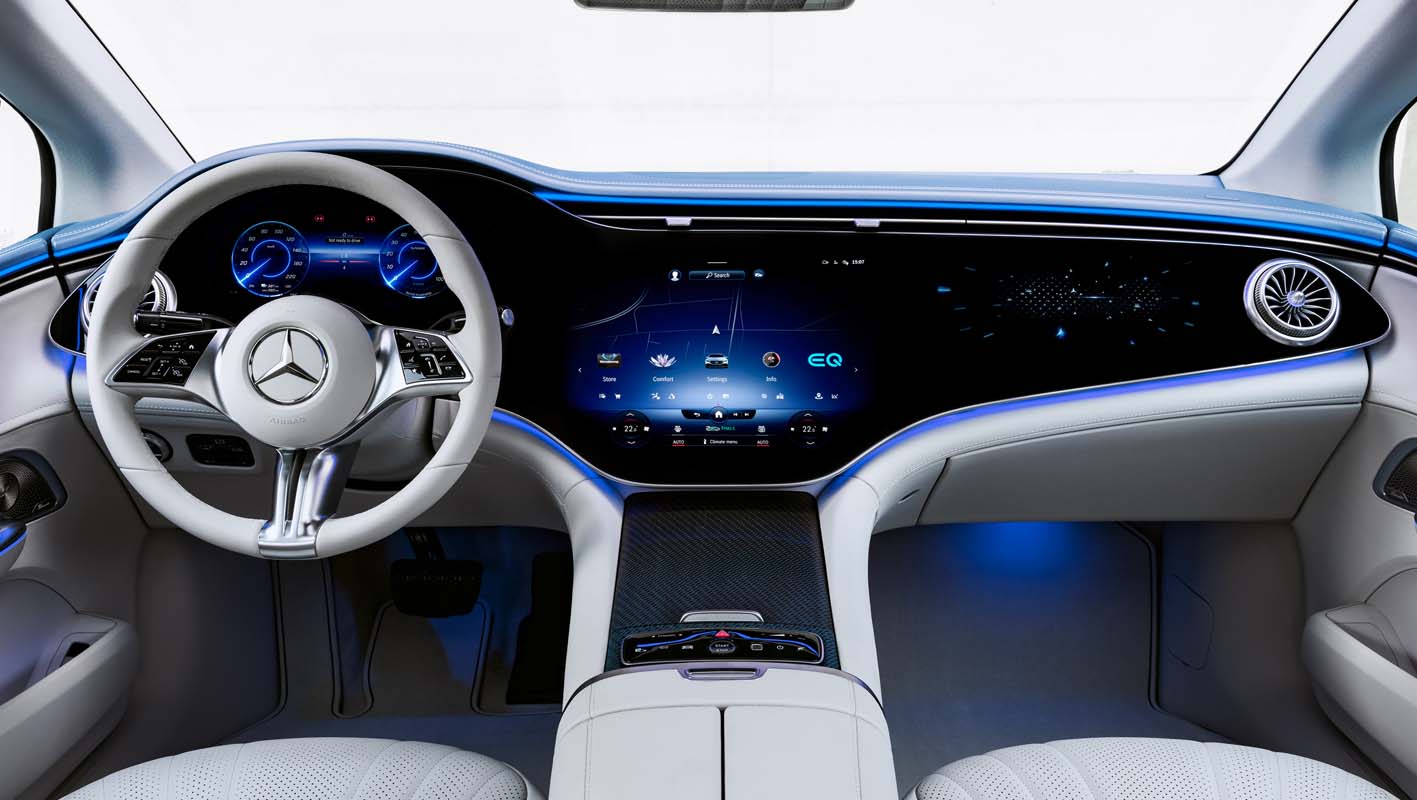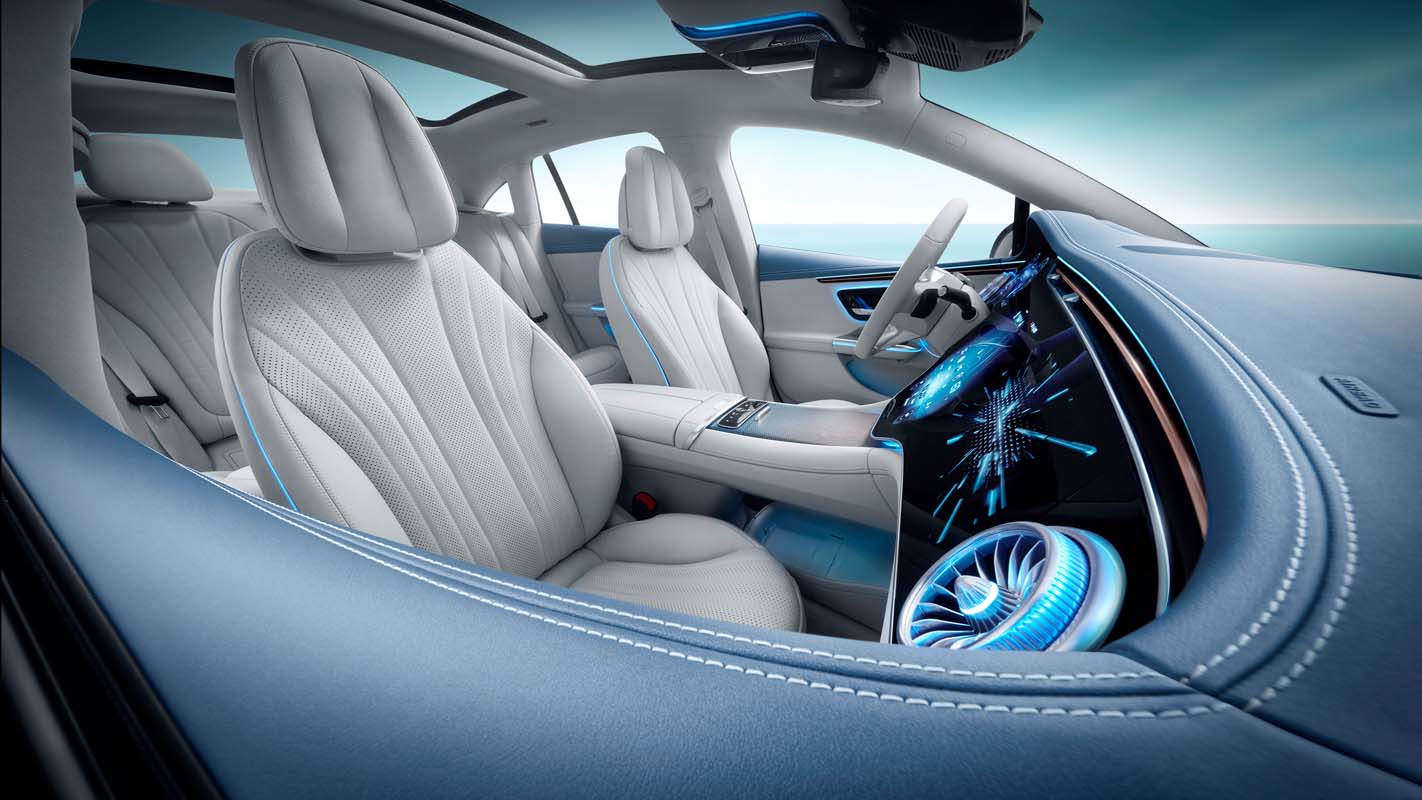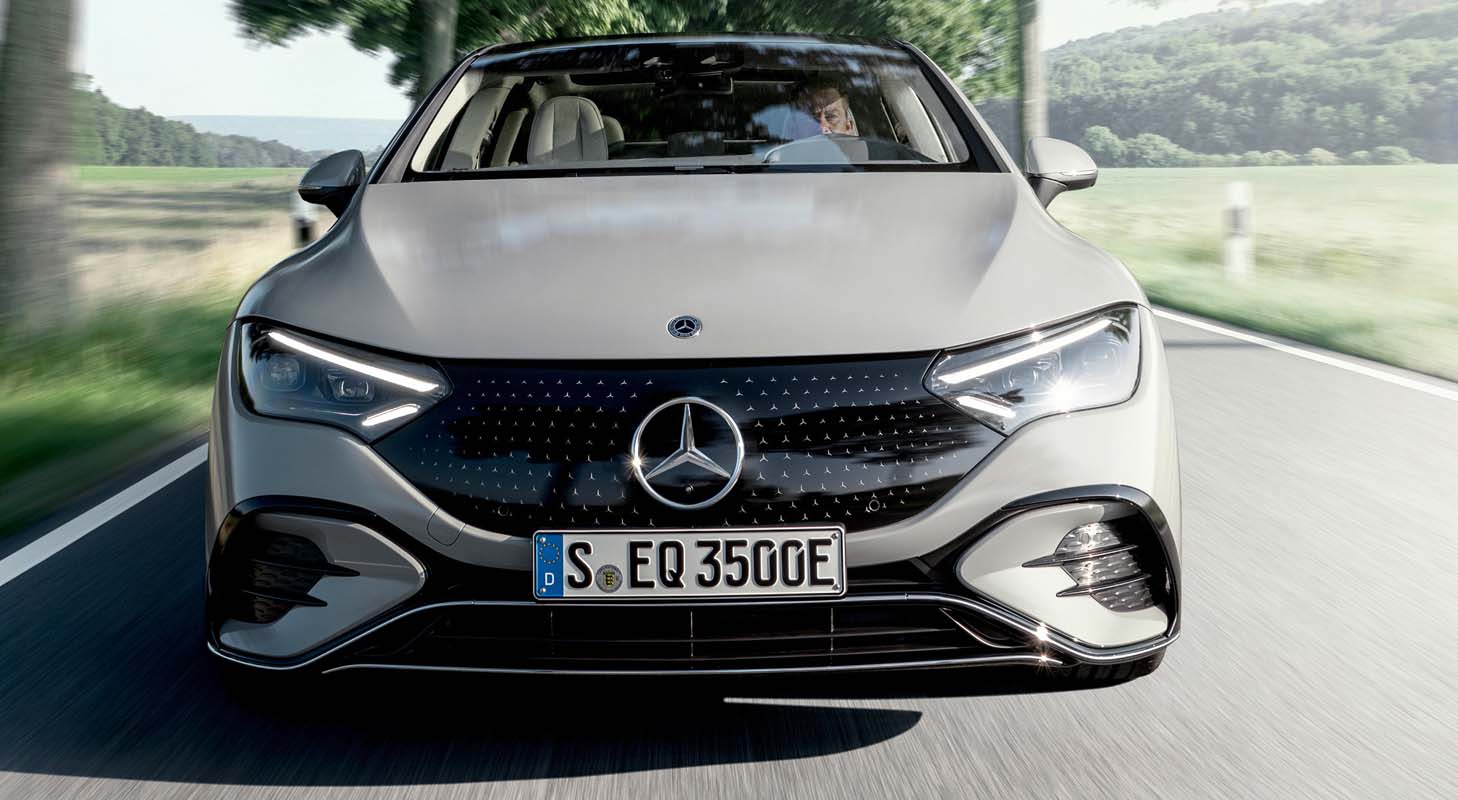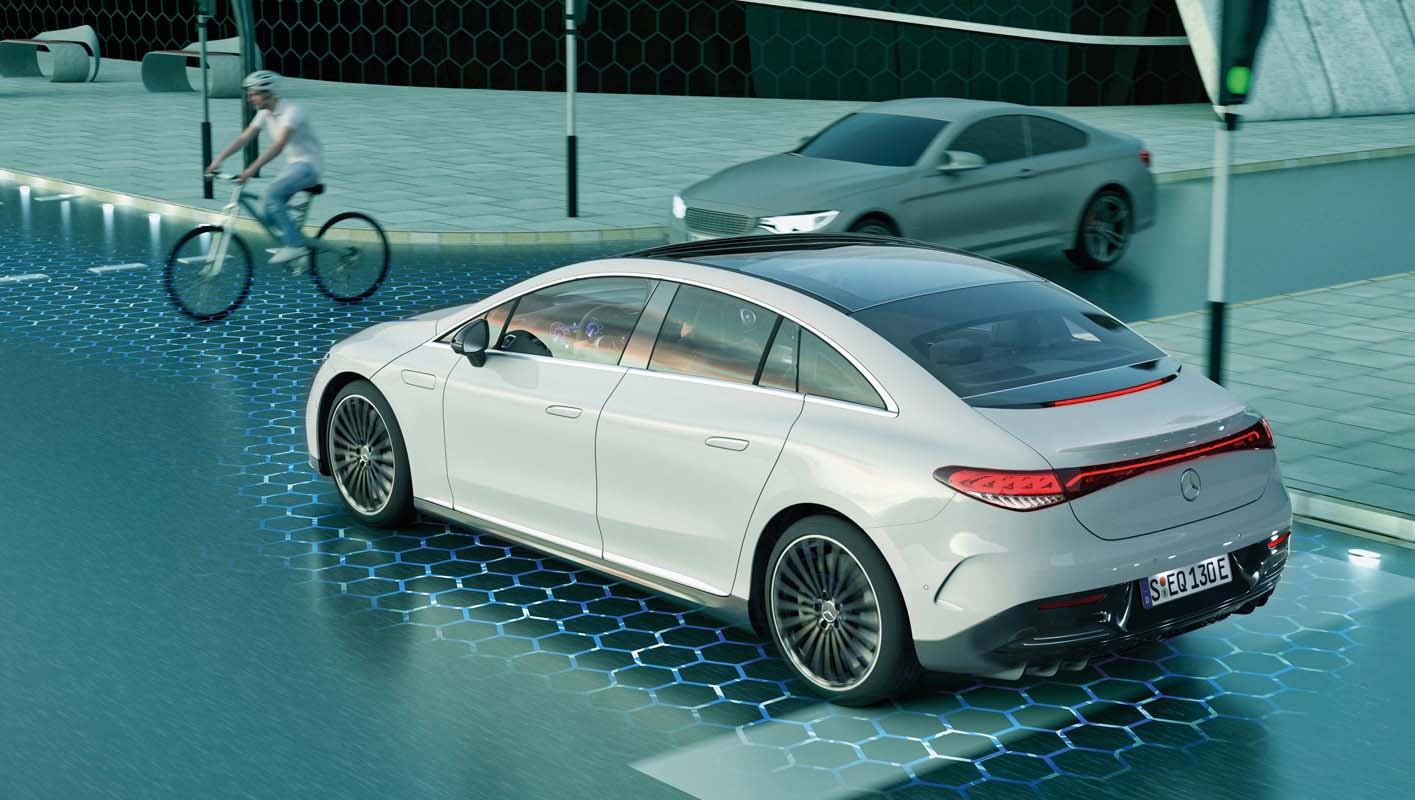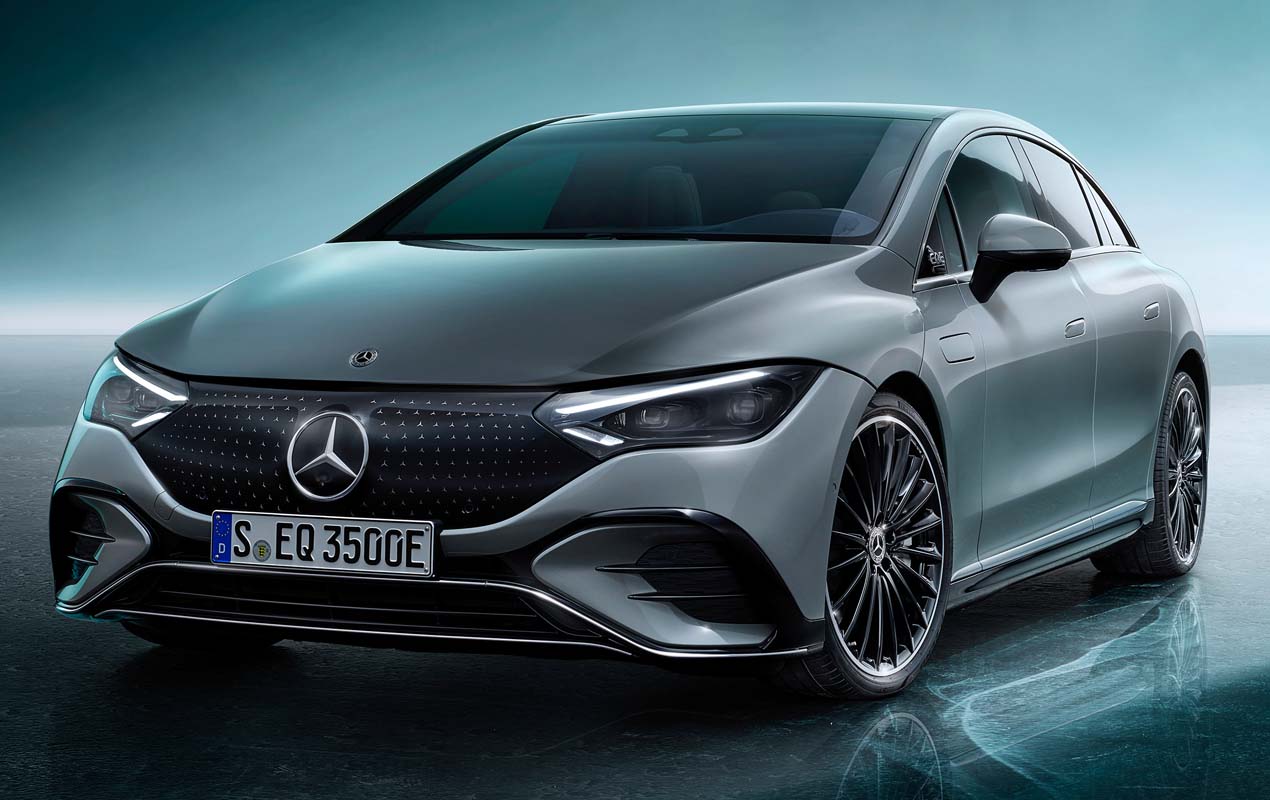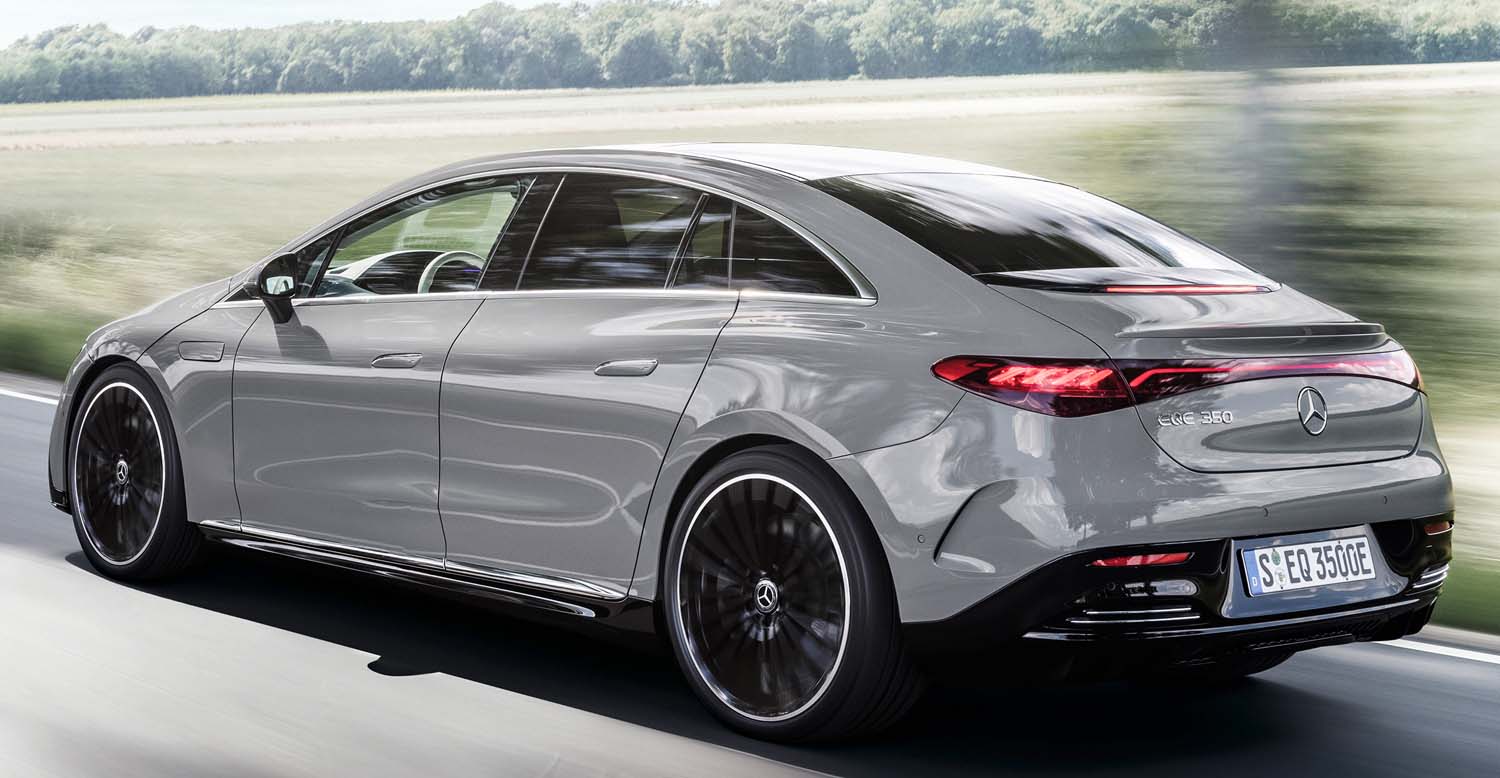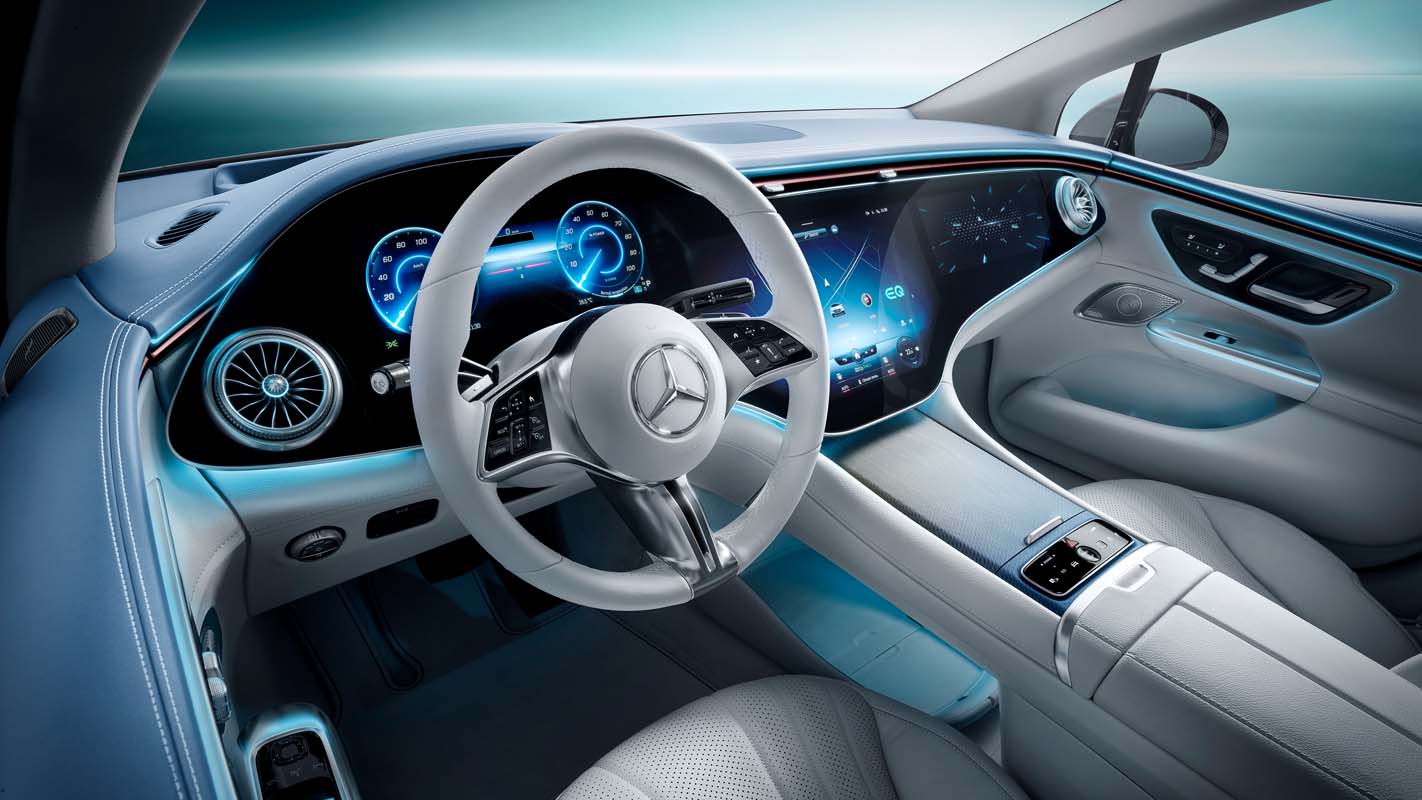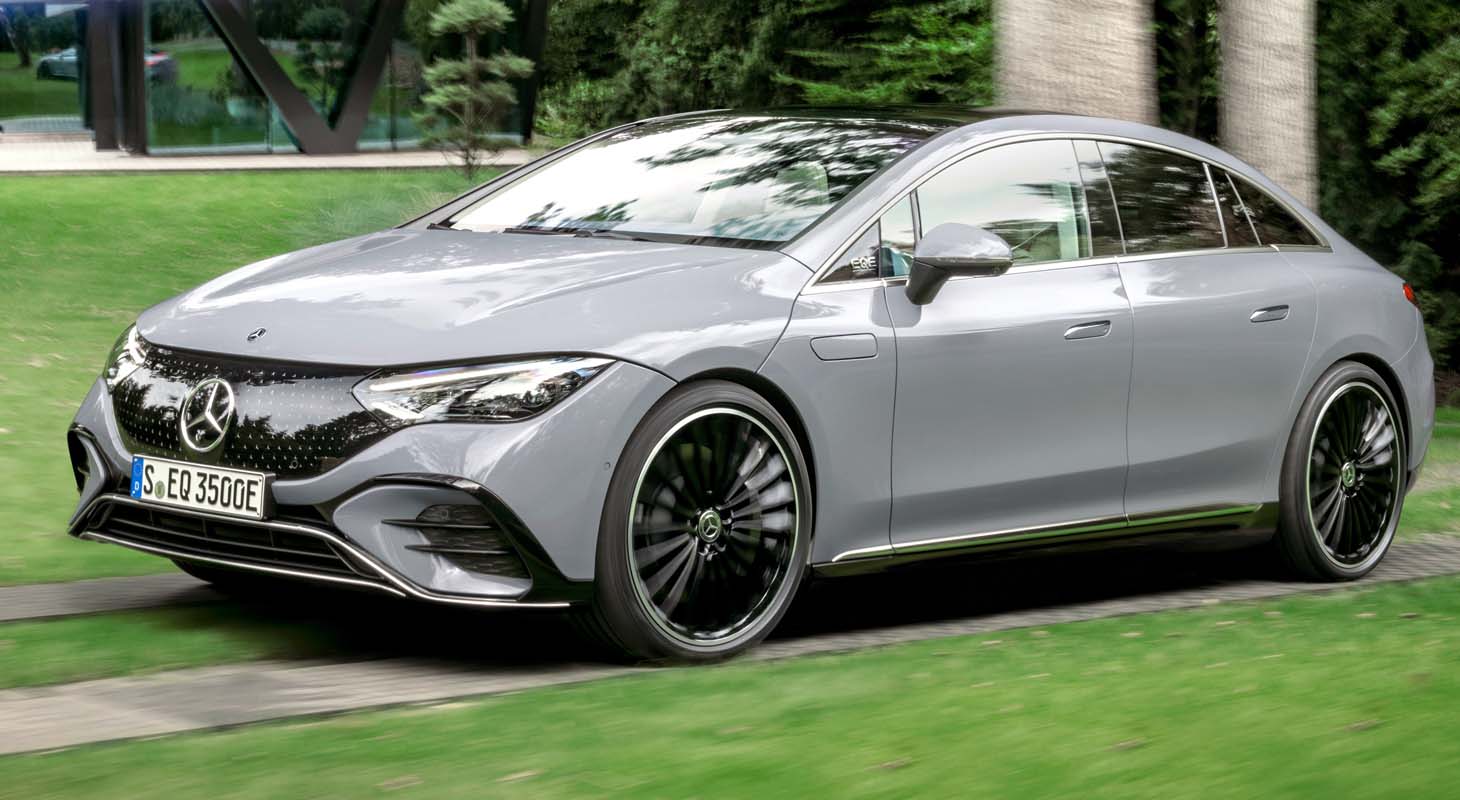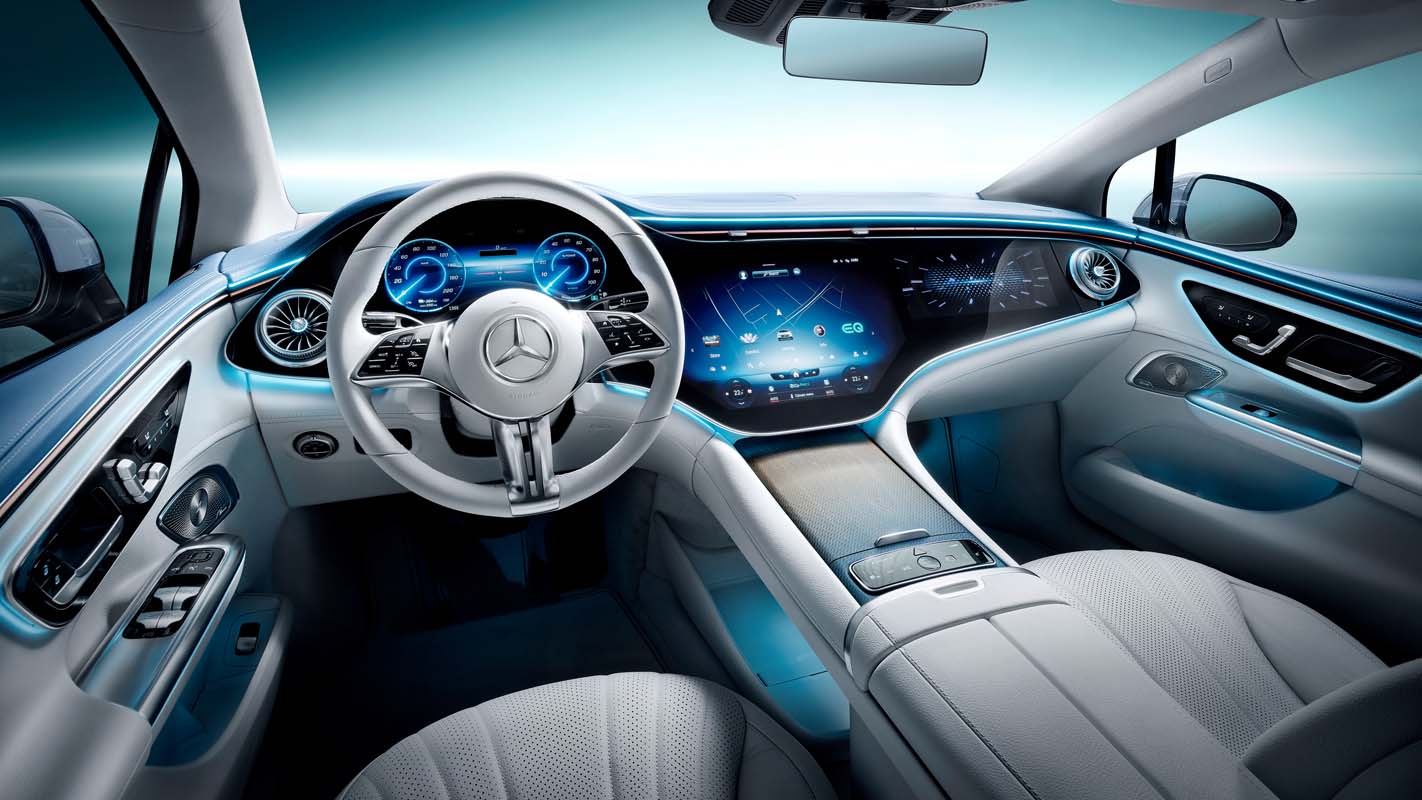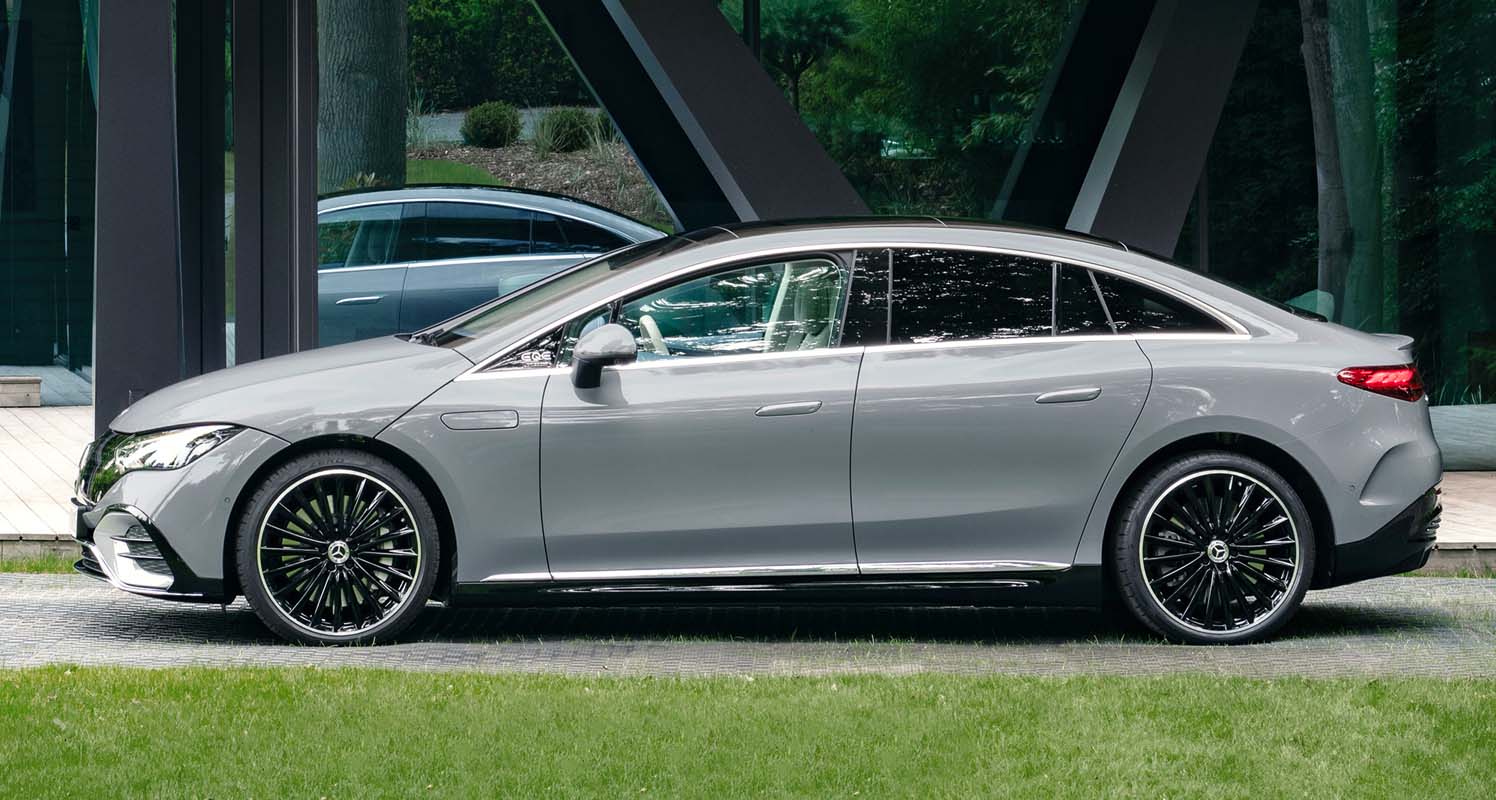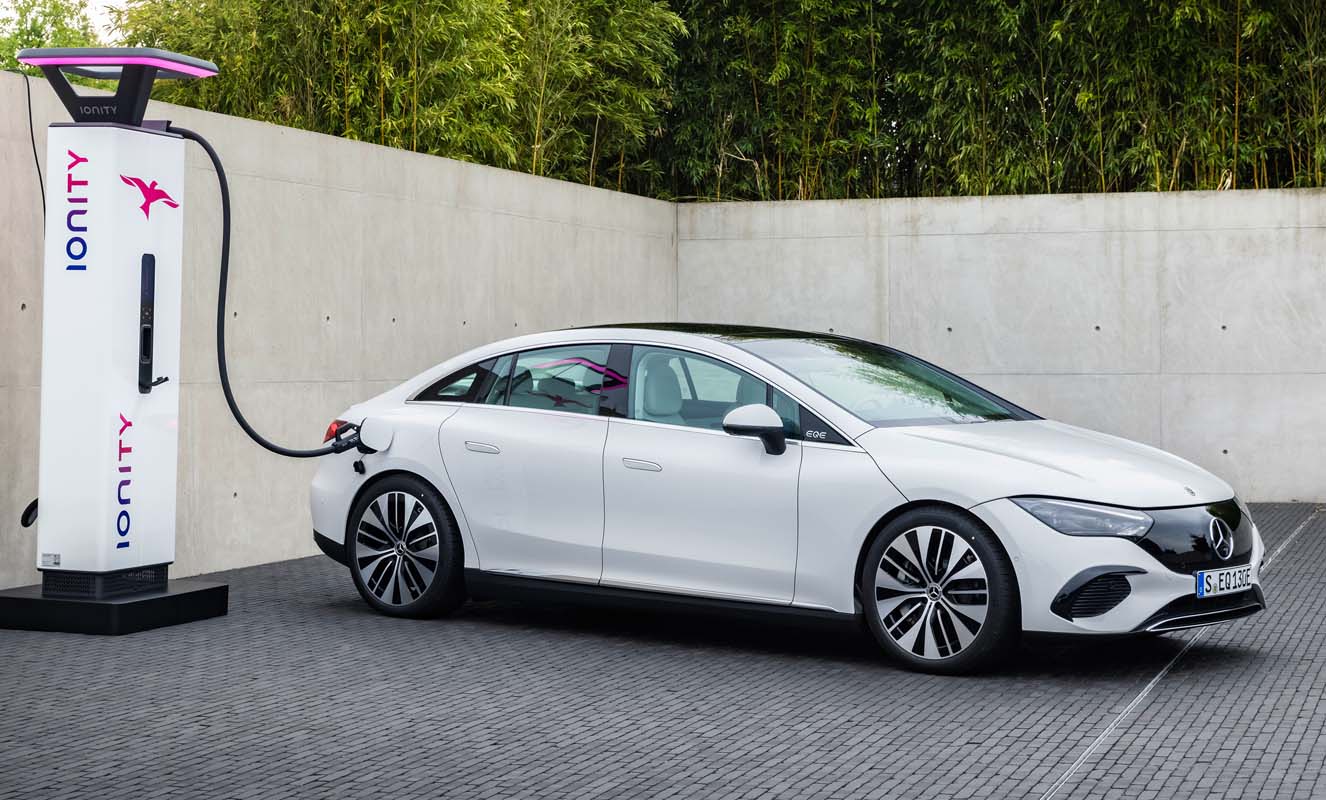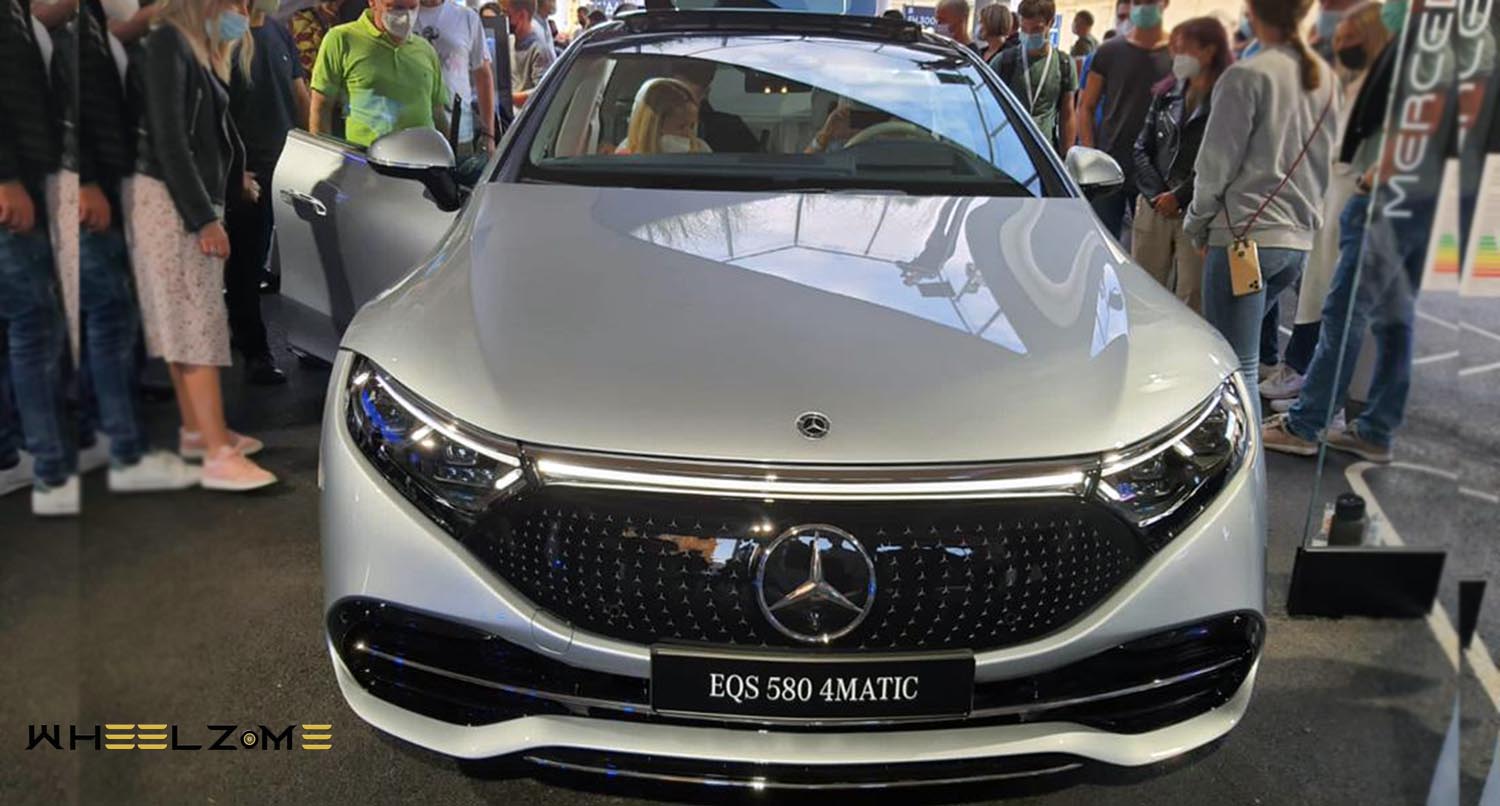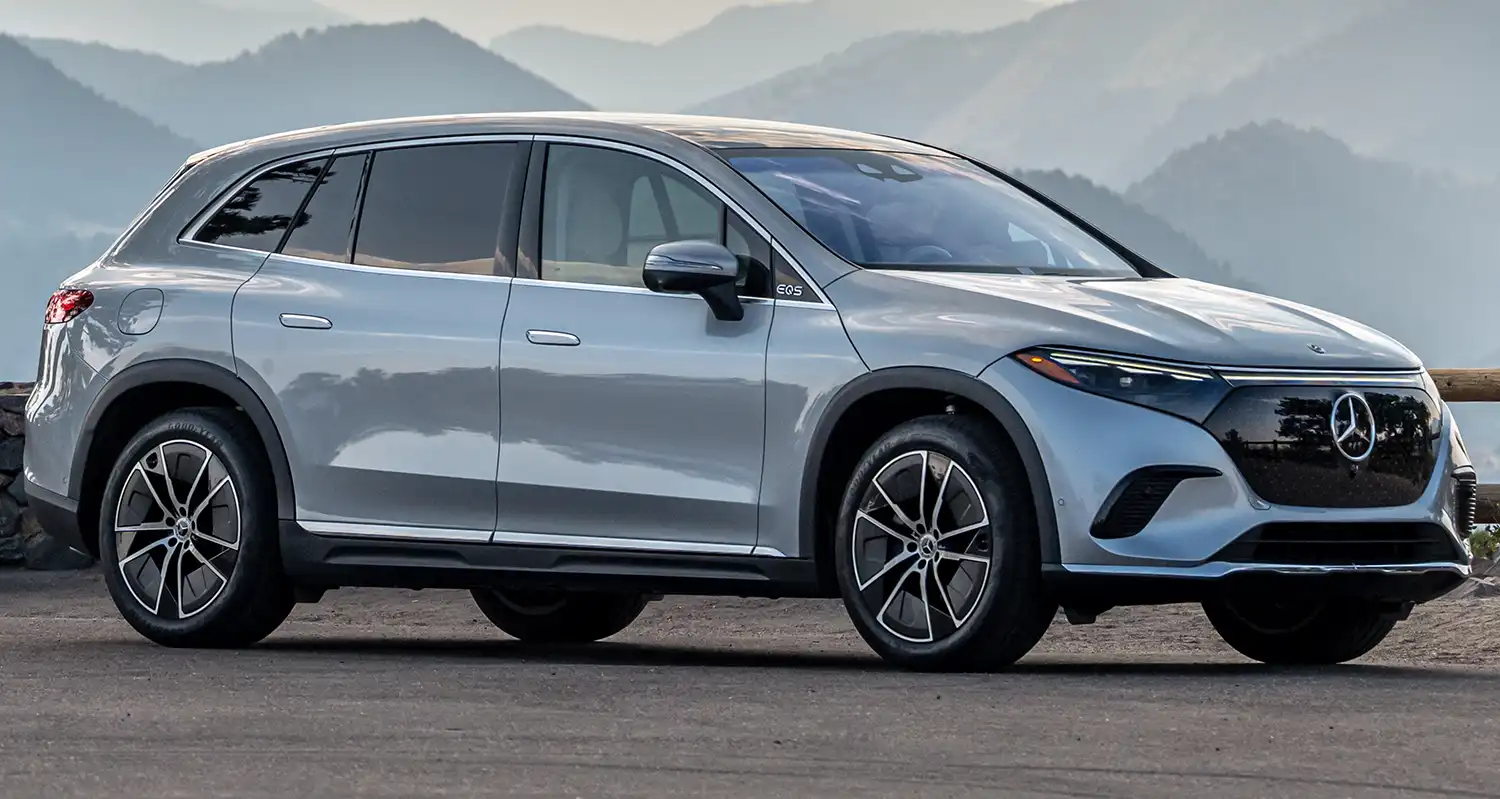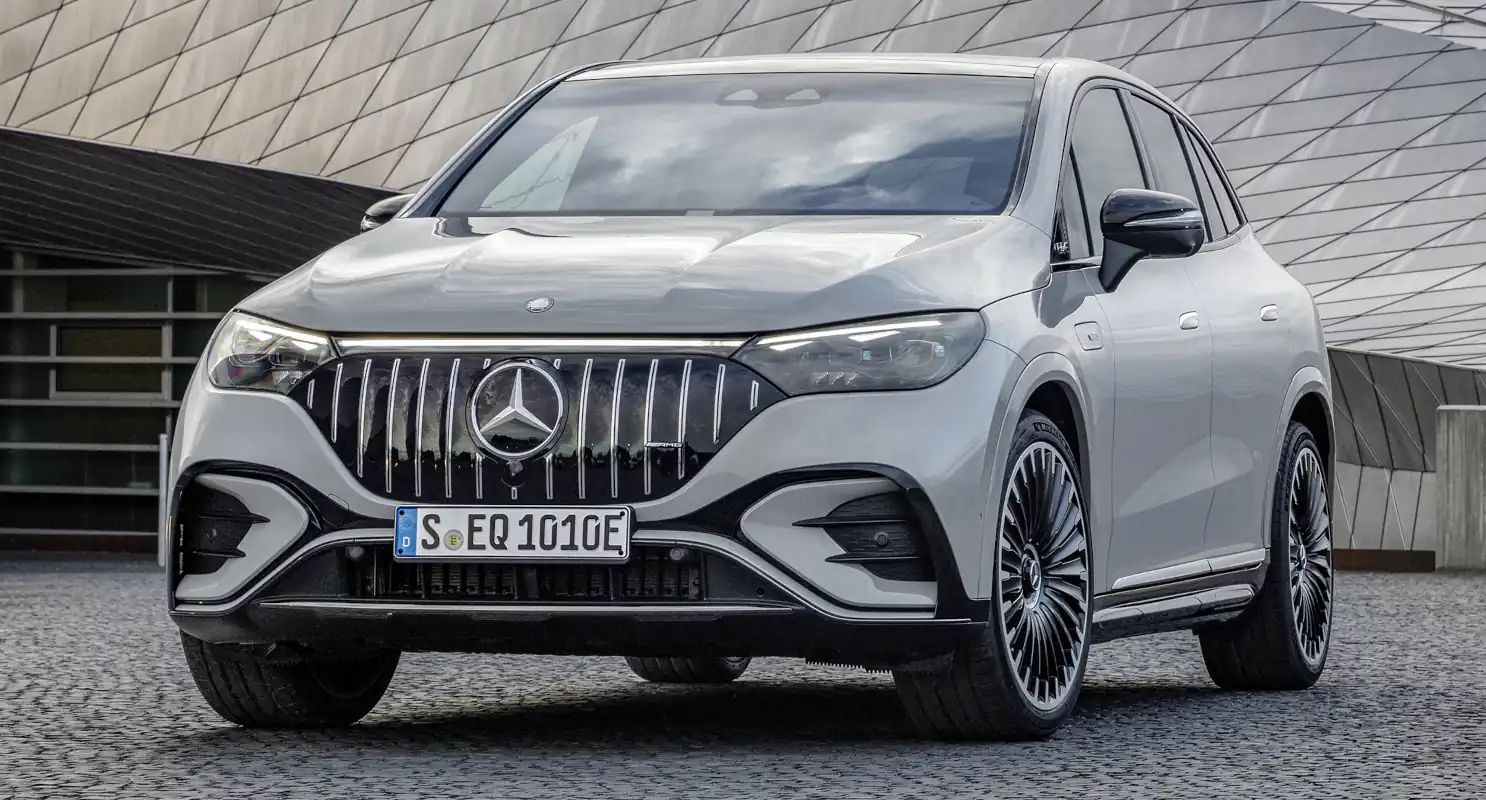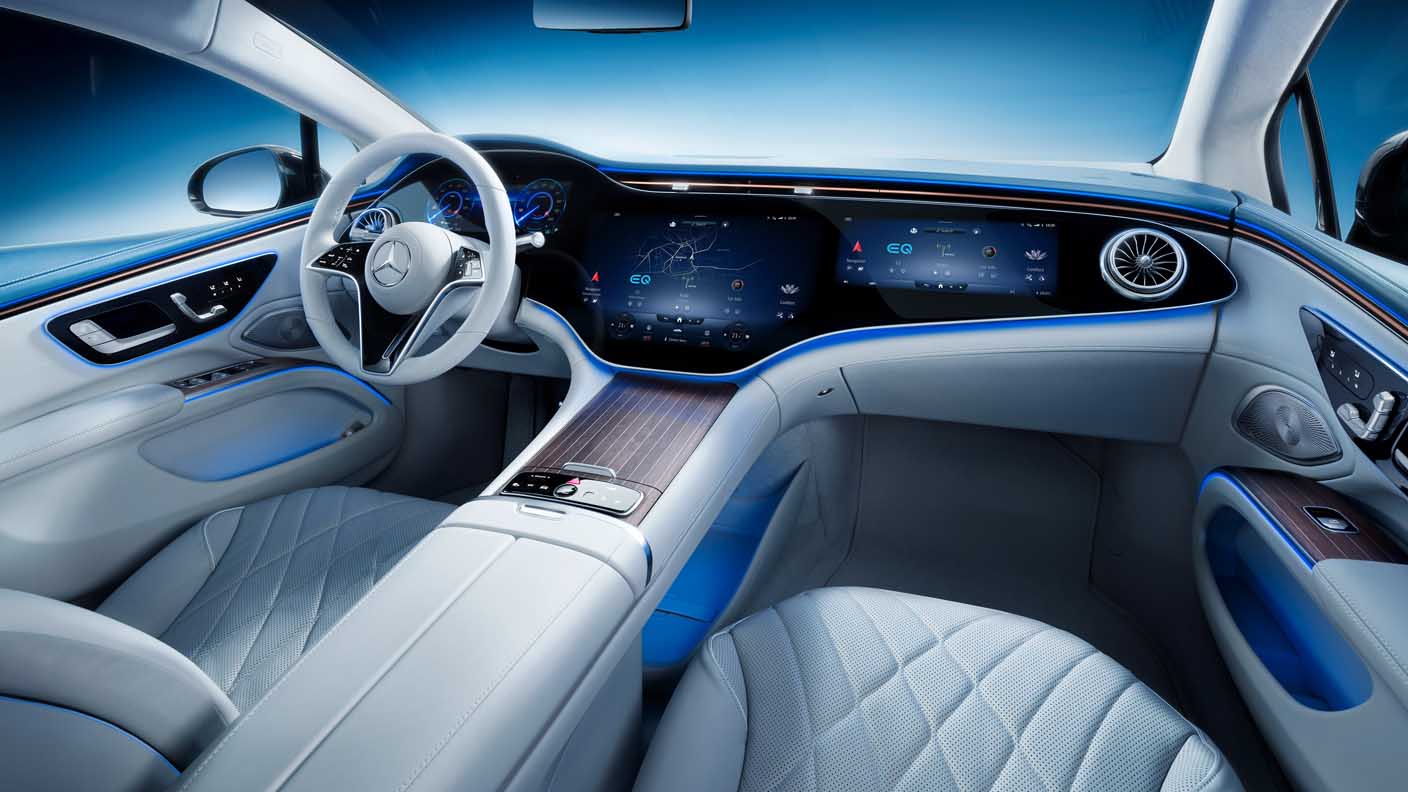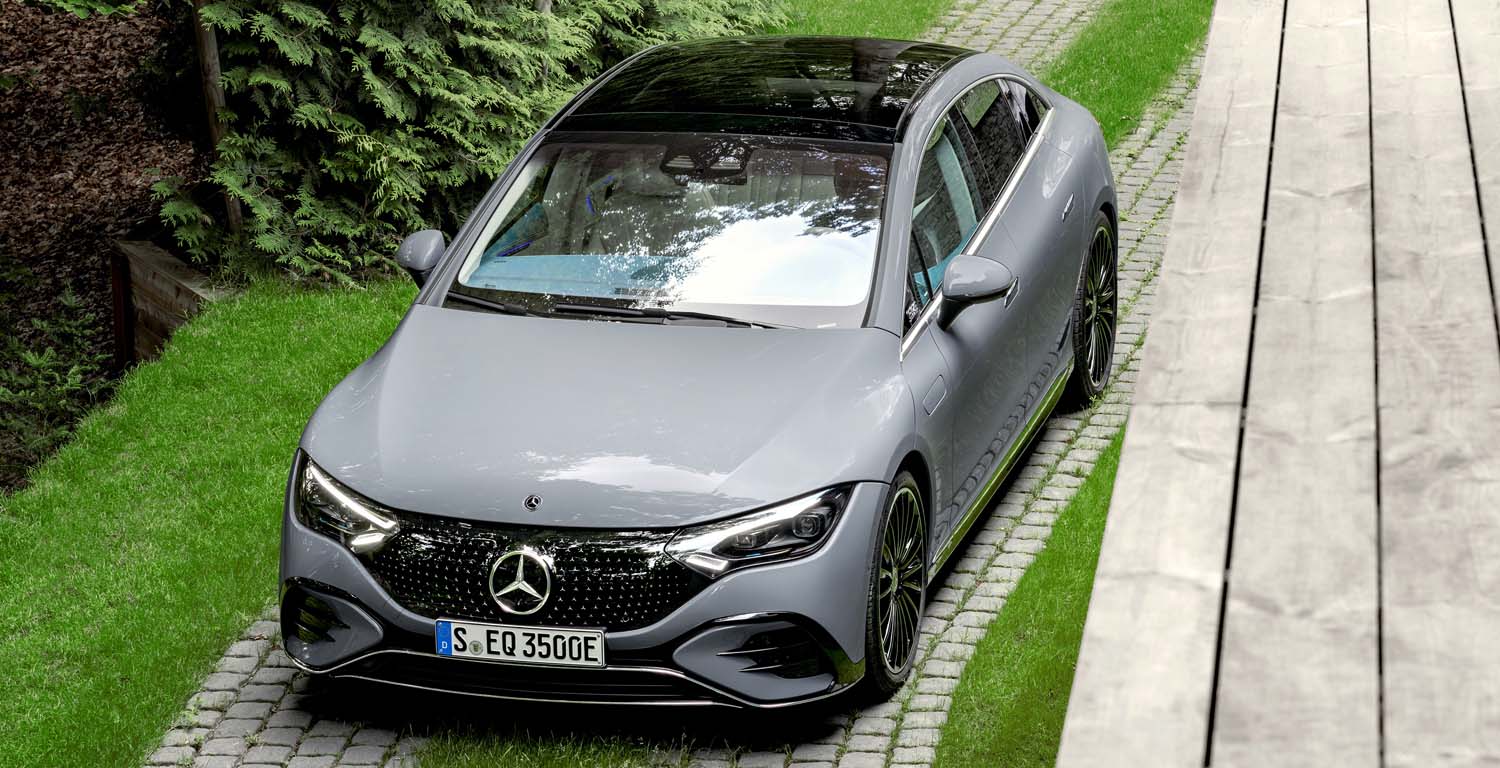
Just a few months after the launch of the EQS, Mercedes-EQ has already presented the next model based on the electric architecture developed specifically for electric vehicles, the new EQE. The sporty business saloon offers all the essential functions of the EQS in a slightly more compact format. At market launch, the model range initially comprises two variants: the EQE 350 with 215 kW, as well as another model. Performance variants with around 500 kW are being planned. Production of the EQE takes place at two locations of the Mercedes-Benz Cars global production network: at the German Mercedes-Benz plant in Bremen for the global market and at the German-Chinese joint venture BBAC in Beijing for the local market.
Compared to the luxury liner EQS, the EQE is even more streamlined, with a slightly shorter wheelbase, shorter overhangs and more recessed flanks – it carries the concept of the business saloon into the future. Sensual Purity is reflected in generously modelled surfaces, reduced joints and seamless transitions (seamless design). The overhangs and the front end are kept short, the rear provides the dynamic accent with a sharp rear spoiler. Flush with the outer edge of the body, the 19- to 21-inch wheels, together with a pronounced muscular shoulder section, give the EQE an athletic character.
In the outer dimensions (length/width/height: 4946/1961/1512 millimetres), the EQE is comparable to the CLS. Like the latter, it has a fixed rear window and a boot lid. The interior dimensions even clearly exceed those of today’s E-Class (213 model series), e.g. the shoulder room in the front (plus 27 mm) or the interior length (plus 80 mm).
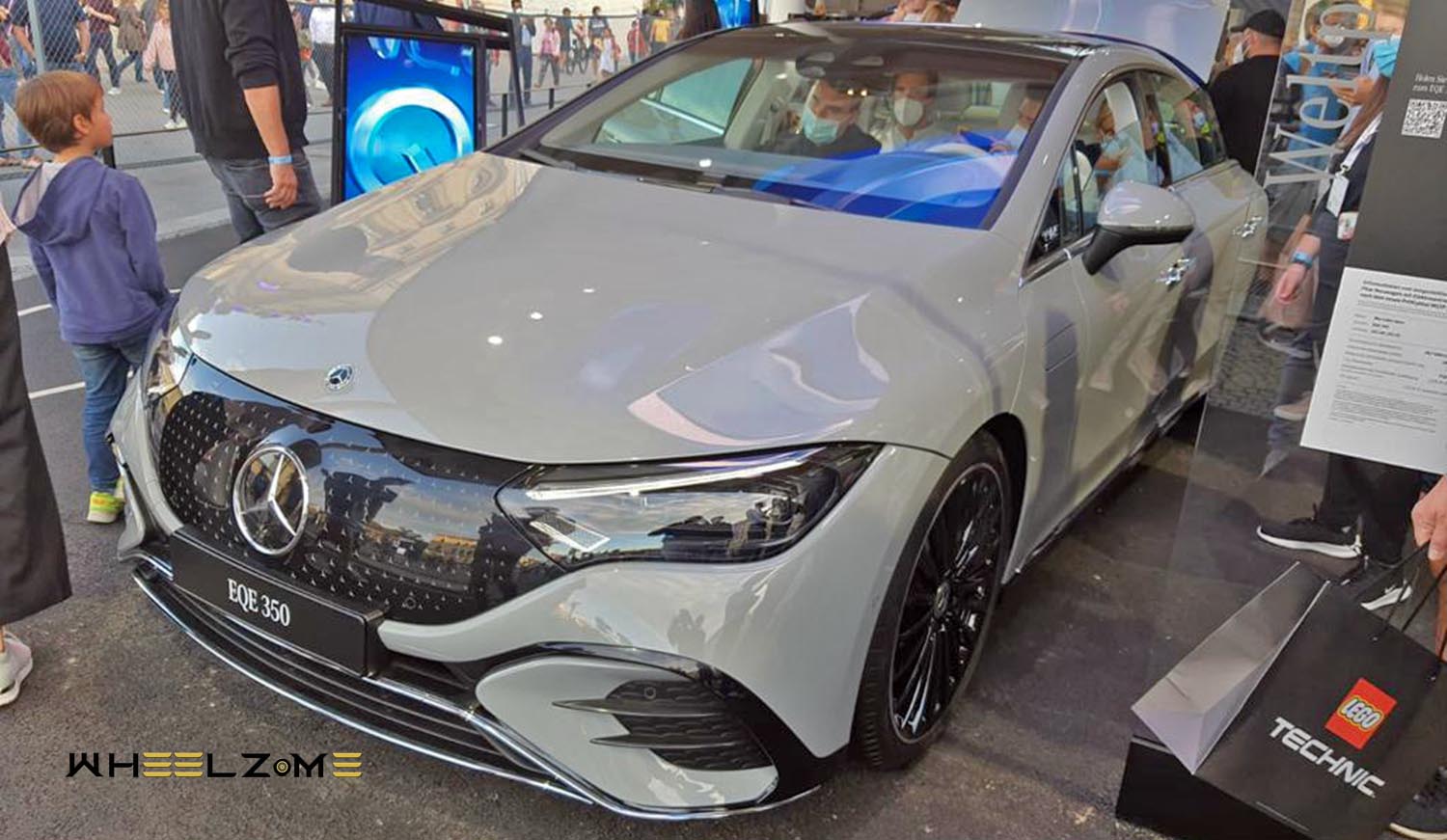
Unconventional interior design and high operating convenience
With the optionally available MBUX Hyperscreen, the entire instrument panel is a single, ultimate widescreen. This determines the aesthetics of the entire cockpit and interior. The high-resolution screens merge seemingly seamlessly under the shared glass cover. The graphic appearance of their MBUX content is perfectly coordinated. The MBUX Hyperscreen is integrated into the instrument panel in minimalist fashion.
The 12.3-inch OLED display for the front passenger gives them their own display and control area. In Europe, the passenger is allowed to watch dynamic content such as videos, TV or internet even when on the move. This is because Mercedes-EQ uses an intelligent, camera-based blocking logic: if the camera detects that the driver is looking at the front passenger display, this is automatically dimmed for certain content.
The vent band spans across the entire width at the top and is very slim at the same time. These extreme proportions, together with the glass wave of the MBUX Hyperscreen, create the avant-garde architecture of the cockpit. The outer nozzles feature a turbine design. They play on the theme hyperanalogue through the contrast between high-tech precision mechanics and digital, glass display world.
The latest MBUX generation, recently introduced in the EQS, is also on board the EQE. With adaptive software, the control and display concept completely adapts to its user and makes personalised suggestions for numerous infotainment, comfort and vehicle functions. With the zero-layer design, the user does not have to scroll through submenus or give voice commands. The most important applications are offered situationally and contextually on the top level in the field of view. In this way the EQE driver is relieved of certain operating steps.
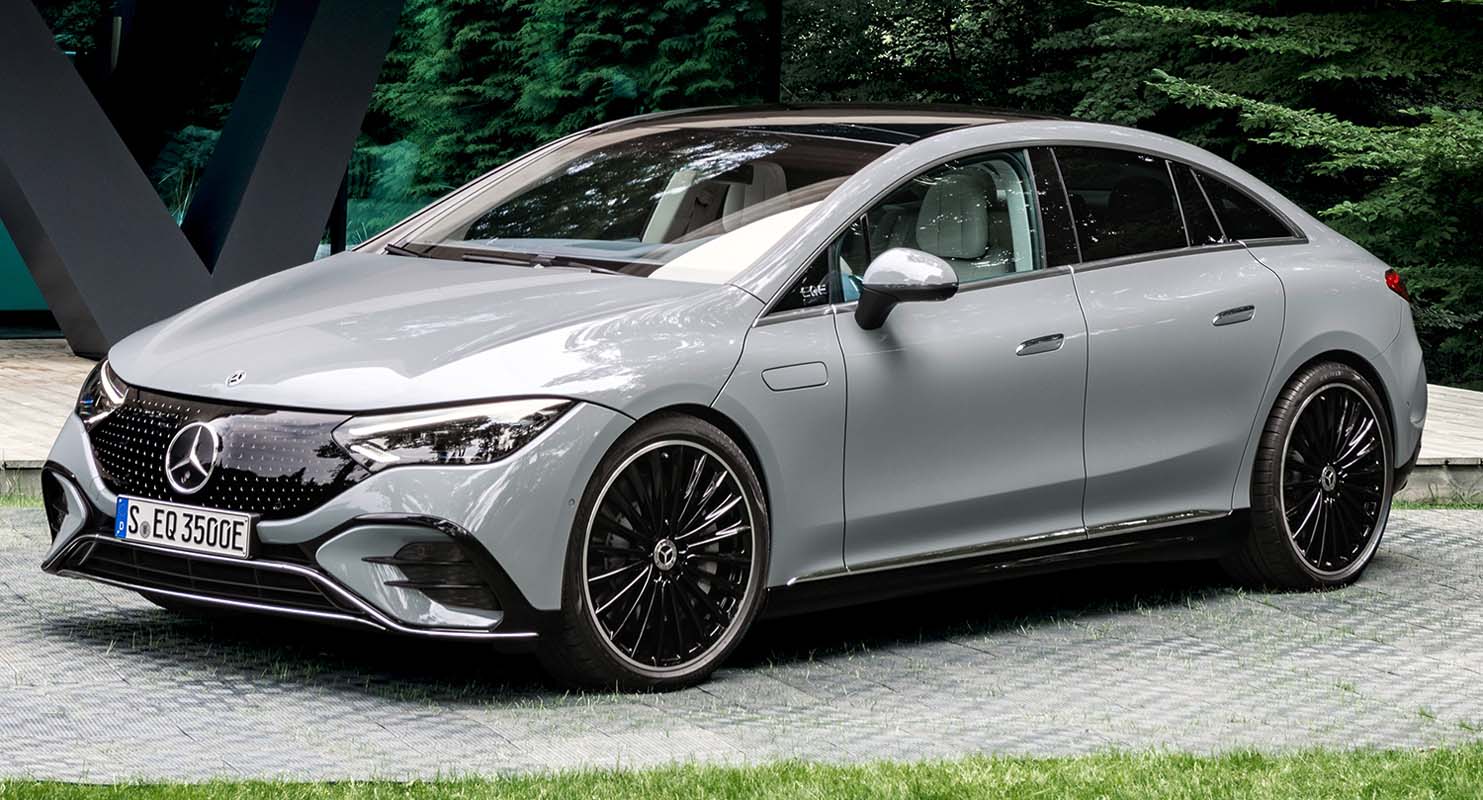
Efficient drive system
The EQE 350 with 215 kW plus a second model will be launched first. Further versions will follow. All EQE models have an electric drivetrain (eATS) on the rear axle. The later versions with 4MATIC are also equipped with an eATS at the front axle. The electric motors are permanently excited synchronous motors (PSM). With the PSM, the rotor of the AC motor is fitted with permanent magnets and therefore does not need to be supplied with power. The advantages of this design include high power density, high efficiency and high power constancy. The motor on the rear axle is particularly powerful due to its six-phase design: it has two windings with three phases each.
In the EQE, the lithium-ion battery consists of ten modules and has a usable energy content of 90 kWh. The innovative battery management software, developed in-house, allows updates over the air (OTA). In this way, the energy management of the EQE remains up-to-date throughout the life cycle.
In the case of the battery, a major step has been achieved in terms of the sustainability of the cell chemistry: the optimised active material consists of nickel, cobalt and manganese in a ratio of 8:1:1. This reduces the cobalt content to less than ten percent. The continuous optimisation of recyclability is part of Mercedes-Benz’s holistic battery strategy.
Consistently high performance and multiple accelerations without a drop in power characterise the EQE’s drive philosophy. This includes a sophisticated thermal concept and several variants of energy recovery by means of recuperation. in this process, the high-voltage battery is charged by converting the mechanical rotary motion into electrical energy during overrun or braking mode. The driver can manually select the deceleration in three stages (D+, D, D-) as well as the gliding function via shift paddles behind the steering wheel. Also available: DAuto.
ECO Assist also offers situation-optimised recuperation – deceleration is so strong or weak that it ultimately results in the most efficient driving style. If possible, recuperative deceleration is also used for vehicles detected ahead. This even occurs until they come to a standstill, for example at traffic lights. The driver does not need to press the brake pedal for this – literally one-pedal driving.
Navigation with Electric Intelligence plans the fastest and most convenient route, including charging stops, based on numerous factors and reacts dynamically to traffic jams or a change in driving style, for example. This includes a visualisation in the MBUX infotainment system as to whether the available battery capacity is sufficient to return to the starting point without charging.
High noise and vibration comfort, Sound Experiences as a contrast
As a saloon with a boot lid, the EQE’s concept is well equipped to offer a high level of NVH comfort Noise, Vibration, Harshness) into account. Numerous measures contribute to this. In the electric drivetrains (eATS), the magnets are arranged inside the rotors in an NVH-optimised way (known as ‘sheet metal cut’). In addition, the eATS have a special foam mat all around as an NVH cover. The inverter cover is a sandwich construction. The eATS are double-decoupled from the body via elastomeric bearings.
Highly effective spring/mass components provide continuous sound insulation from the crossmember under the windscreen to the floor of the boot. Acoustic foams are inserted into many carriers during body-in-white construction.
If desired, the ride in the EQE nevertheless becomes an acoustic experience: If the Burmester® surround sound system is on board, the EQE has the two soundscapes: Silver Waves and Vivid Flux. Silver Waves is a sensuous and clean sound. Aimed at EV enthusiasts, Vivid Flux is crystalline, synthetic yet humanly warm. They can be selected or switched off as sound experiences on the central display. The additional soundscape Roaring Pulse can be activated as an over-the-air update. This sound experience is reminiscent of powerful machines, and is sonorous and extroverted.
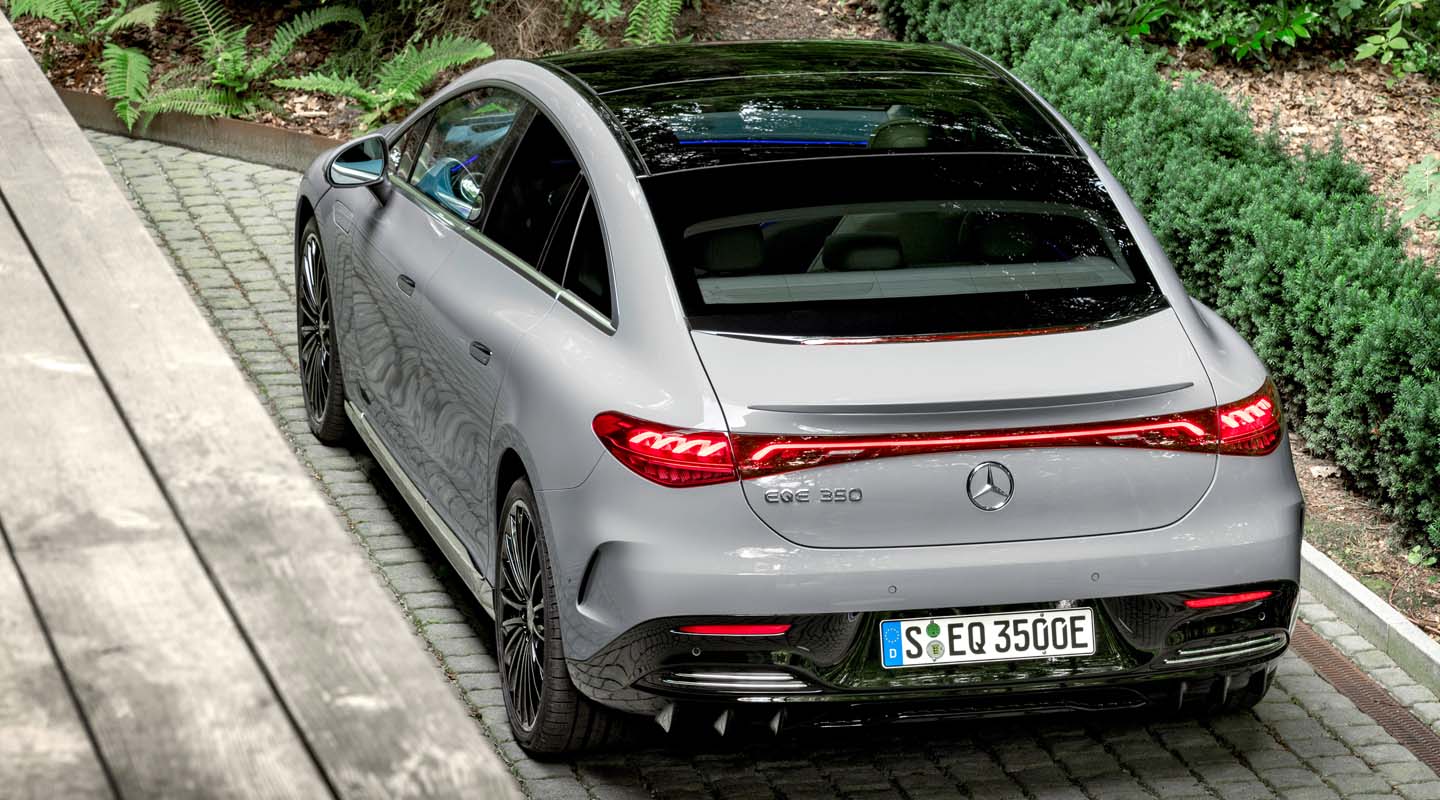
Air suspension and rear-axle steering as options
The suspension of the new EQE, with four-link front suspension and multilink rear suspension, is closely related in design to the new S-Class. As an option, the EQE is available with AIRMATIC air suspension with ADS+ adaptive damping system. With rear-axle steering (optional extra), the EQE feels as manoeuvrable as a compact car in the city. The steering angle at the rear axle is up to ten degrees. The turning circle is reduced from 12.5 to 10.7 metres with rear-axle steering.
New vehicle functions can be activated via over-the-air technology (OTA). Available from launch: the additional sound experience “Roaring Pulse”, two special driving modes for young drivers and service personnel, small games, the highlight mode as well as DIGITAL LIGHT with projection function and DIGITAL LIGHT individualisation. In Highlight mode the vehicle presents itself and its equipment highlights – this is activated by the “Hey Mercedes” voice assistant. In addition to the light animation “Digital Rain”, DIGITAL LIGHT individualisation includes other coming-home/leaving animations such as “Brand World”. The OTA functions are available in the Mercedes me Store, and the range will be successively expanded.
Convenient charging in a large charging network
With the new Mercedes me Charge Plug & Charge function, the EQE can be charged even more conveniently at Plug & Charge-enabled public charging points: when the charging cable is plugged in, the charging process starts automatically; no further authentication by the customer is required. The vehicle and the charging station communicate directly via the charging cable.
What’s more, Mercedes me Charge customers continue to benefit from the integrated payment function with automatic payment. The customer chooses the preferred payment method only once. Every charging process is then automatically debited – including abroad. The individual charging processes are clearly listed in a monthly invoice.
Mercedes me Charge is one of the largest charging networks worldwide: it currently has more than 530,000 AC and DC charging points in 31 countries, including over 200,000 in Europe. By means of high-quality certificates of origin, Mercedes-Benz guarantees that energy from renewable energy sources is fed into the grid for charging current sourced via Mercedes me Charge.
High level of passive and active safety
The principles of Integral Safety, in particular accident safety, apply regardless of the platform. Like all other Mercedes-Benz models, the EQE therefore has a rigid passenger cell, special deformation zones and modern restraint systems with PRE-SAFE®.
The fact that the EQE is based on an all-electric architecture also opened up new design possibilities for its safety concept. It meant, for example, that a favourable location could be chosen for the installation of the battery, in a crash-protected area in the underbody. And because there is no large crankcase on board, the behaviour in a frontal crash could be modelled even better. In addition to the standard crash tests, the car’s performance in various additional load situations was verified and extensive component tests carried out at the Vehicle Safety Technology Centre (TFS).
The latest generation of driving assistance systems includes numerous driver support functions. One new function is the additional microsleep warning from ATTENTION ASSIST (in conjunction with MBUX Hyperscreen). It analyses the driver’s eyelid movements using a camera in the driver display. The assistance display within the driver’s display shows the operation of the driving assistance systems in a comprehensible full-screen view.
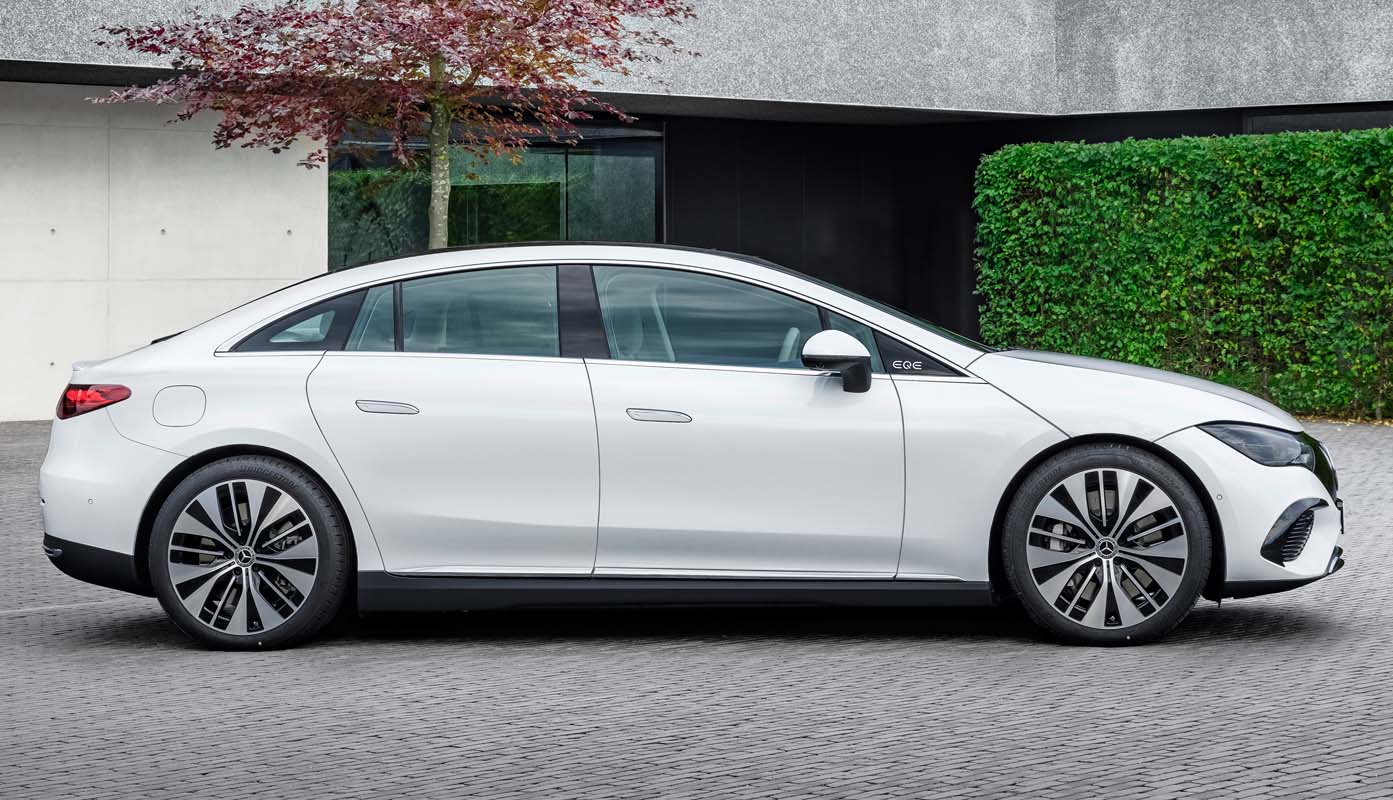
The exterior design
The EQE features a sporty ‘purpose design’ with all the characteristic elements of Mercedes-EQ, one-bow lines and cab-forward design. Sensual Purity is reflected in generously modelled surfaces, reduced joints and seamless transitions (seamless design). The overhangs and the front end are kept short, the rear provides the dynamic accent with a sharp rear spoiler. Flush with the outer edge of the body, the 19- to 21-inch wheels, together with a pronounced muscular shoulder section, give the EQE an athletic character.
Compared to the luxury liner EQS, the EQE is even more streamlined, with a slightly shorter wheelbase, shorter overhangs and more recessed flanks – it carries the concept of the business saloon into the future.
The sporty, low and slim front of the EQE forms a coupé-like silhouette with a bow (one bow) stretched tightly over the greenhouse. The A-pillar, which has been moved far forward, and the C-pillar at the rear create space for a generous passenger compartment. Unique in this segment is the cab-forward design: The overhangs and the front-end assembly are short, the rear forms a dynamic accent with a sharp rear spoiler. Flush with the outer edge of the body, the 19- to 21-inch wheels, together with a muscular shoulder section, give the EQE an athletic character.
The design philosophy of Sensual Purity is implemented with the clear, flowing design. Tense, sinewy surfaces emphasise the athleticism, and the claim of seamless design is confidently realised with reduced lines and flowing transitions. Aerodynamics and formal aesthetics are synergistically coordinated. The detailed design expresses innovation and exclusivity.
Black Panel front with Mercedes-Benz pattern on request
The front is combined into a ‘Black Panel’ unit. Innovative headlights and the deep black radiator grille (Black Panel) form the athletic face and simultaneously position the EQE as a member of the new Mercedes-EQ vehicle generation. In addition to its unique look, there is also function behind the Black Panel surface: the various sensors of the driving assistance systems such as ultrasound, camera and radar are integrated. The concise daytime running light signet interprets the brand’s characteristic flare. LED High Performance headlamps are standard, DIGITAL LIGHT combined with the flare as daytime running lights is available as an optional extra.
The exclusive look of the Black Panel radiator grille with the central Mercedes star can be enhanced still further: in conjunction with AMG Line exterior or Electric Art exterior, they are also available as an optional extra with the Mercedes-Benz pattern, a three-dimensional star pattern. This references the original star of the Daimler-Motorengesellschaft company, which was registered as a trademark in 1911. The seamless design is reflected in the front-end design in particular. Examples include the reduced gap dimensions and overlapping bonnet. The latter does away with the traditional divide between bonnet and wings.
Striking one-bow lines
The aerodynamic silhouette with frameless, coupé-like doors and the high, arched beltline are independent design elements in the profile. The outside mirrors sit on the beltline and are aerodynamically and aero-acoustically optimised. Chrome accents highlight design focal points like the one-bow lines of the window graphics. High-quality painted contrasting surfaces can be found in the lower area of the vehicle. Stone chip protection has been integrated into the chrome trim.
The service flap for wiper fluid was integrated into the side of the left wing. The bonnet is only opened by the specialist workshop for maintenance work, such as replacing the interior air filter.
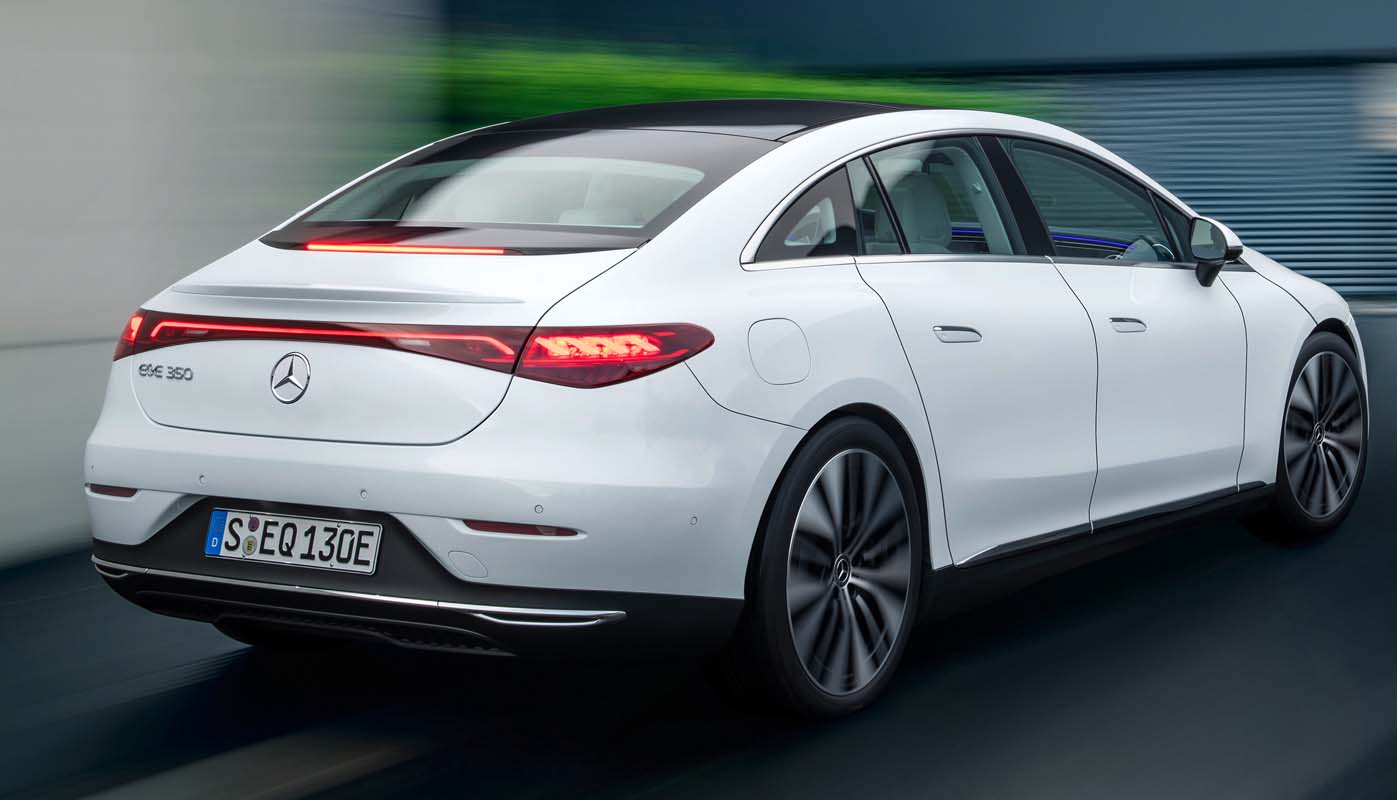
Light band with LED lamps in 3D helix design
The sporty, coupé-like rear carries a rear spoiler with a sharp spoiler lip. The large rear window, which extends downwards from the roof in a flowing contour, is a distinctive feature. For the first time, the components of the various aerials are hidden underneath, invisible from the outside. The boot lid joins the windscreen with a slight gradation and unobtrusively incorporates the additional brake light. The rear camera is hidden behind the star, protected from dirt. Another highlight at the rear are the innovatively designed LED lights: their insides have the shape of a curved and illuminated 3D helix. The EQE has a continuous light band at the rear – a distinguishing feature of Mercedes-EQ vehicles.
The interior design
The EQE is the new business class from Mercedes-EQ. With this completely new vehicle, the designers had the brief and the opportunity to take a completely new approach to the interior design as well. They used this freedom and, in addition to the MBUX Hyperscreen, relied on consistent digitalisation and avant-garde design for many other elements.
Like the EQS, the EQE is based on a large electric platform from Mercedes-EQ. For the designers, this went hand in hand with the vision of systematic digitalisation of the interior. The optionally available MBUX Hyperscreen implements this vision in a particularly impressive way: the entire instrument panel is one ultimate widescreen. This determines the aesthetics of the entire cockpit and interior. The real glass appears to drape itself three-dimensionally over the entire width of the vehicle like a wave – a unique feature in automotive construction to date.
The high-resolution screens merge seemingly seamlessly under the shared glass cover. The graphic appearance of their MBUX content is perfectly coordinated. The MBUX Hyperscreen is integrated into the instrument panel in minimalist fashion. Only a fine frame in silver shadow, a band of nozzles and a narrow leather ledge enclose the MBUX Hyperscreen. The leather ledge is reminiscent of the lower section of classic instrument panels.
The vent band spans across the entire width at the top and is very slim at the same time. These extreme proportions, together with the glass wave of the MBUX Hyperscreen, create the avant-garde architecture of the cockpit. For further details on the MBUX Hyperscreen, see separate chapter.
The dominant outer vents have a turbine design. They deliberately play on the theme of hyperanalogue through the contrast between high-tech precision mechanics and digital, glass display world. The intricately designed turbine blades distribute the airflow efficiently.
The front section of the centre console joins the instrument panel and stands freely in space. It is a visual reference to the new drive architecture – due to the electric powertrain, no transmission tunnel is necessary. Flowing leather surfaces with intricate seam dressings create a modern and luxurious impression in combination with the large-scale real wood blind. At the same time, there is plenty of practical storage space available.
The base model without MBUX Hyperscreen has a slightly different centre console. There is a soft armrest in the rear section. It is first visually interrupted before being transitioned into the floating central display. The smooth transition from 3D in the centre console compartment to 2D on the touchscreen is seamless, i.e. without interrupting the glass look, and is unique.
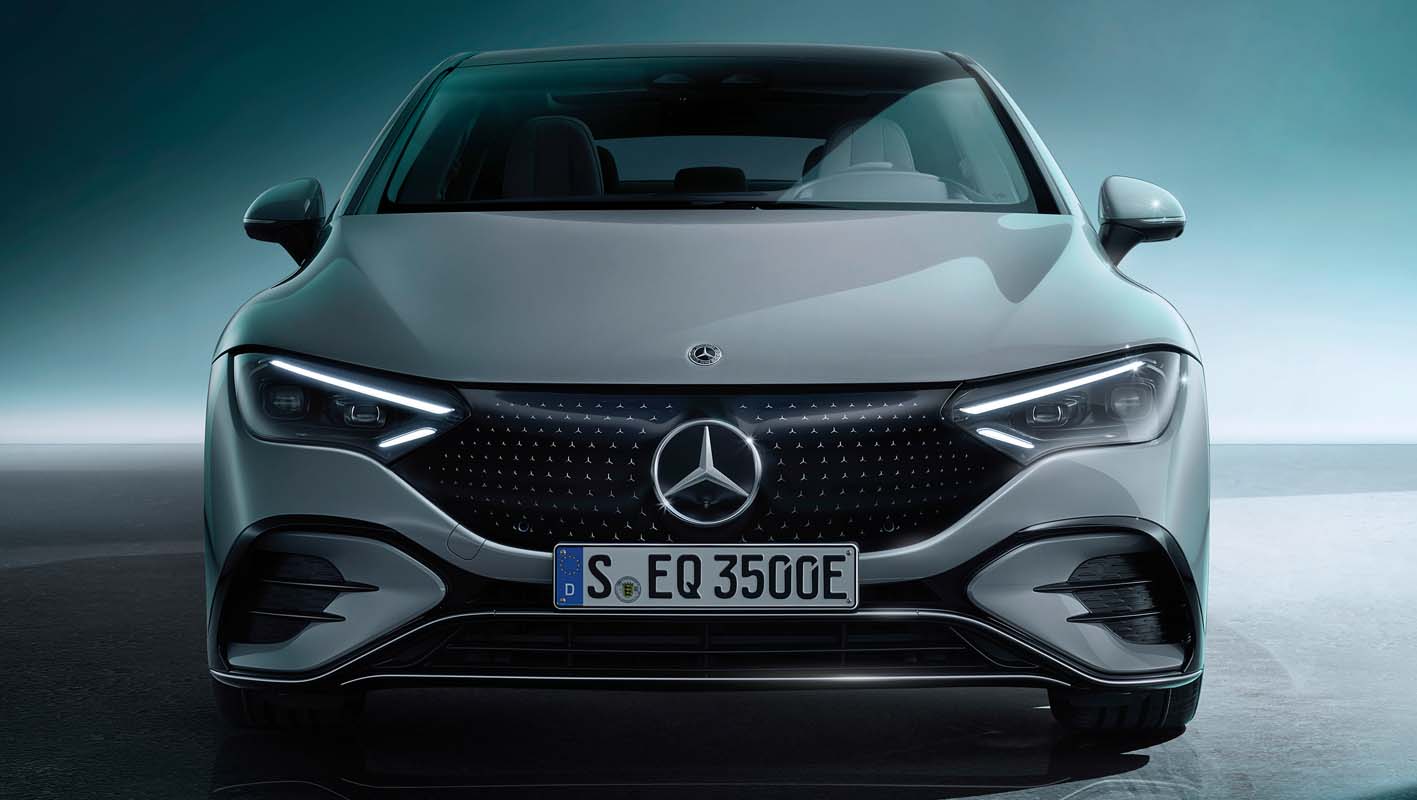
Door trim modern, avant-garde and extremely reduced design
The vent band from the cockpit is visually continued in the driver’s doors. A floating control cluster with integrated door opener and seat controls takes over the functional interpretation of formerly purely decorative elements. The door centre panel develops in a sensual, dynamic movement from the vertical surface into the horizontal and thus integrates the armrest seamlessly. The front section of the armrest is designed as a metallic high-tech element that can be used as a free-floating grab and pull handle and contains the power window switch. In the dark, this floating, avant-garde aesthetic is particularly impressive thanks to an ambient light corona.
Seats: elaborately processed materials and perforations
The EQE comes with the Electric Art interior ex factory. Standard equipment includes the comfort seats. Despite their simplicity of design, they captivate with their sculptural beauty. Wrap-around surfaces in the side bolsters create the body support and stand in stark contrast to the seat centre panel. It has a sophisticated seam pattern similar to a fan palm.
In combination with AMG Line interior, the EQE receives the sports seats. These are characterised by a slim and monolithic shape and act like integral seats. The seat surfaces are designed in such a way that they give the impression of draped-on leather covers. The technical term is “layering”.
Common features of all leather seats are the dynamic graphic patterns with highly elaborate perforations. Here, too, you will find the hallmark Mercedes-EQ combination of the highest standards in materials, ambience and workmanship as well as state-of-the-art technology.
Colour & trim: avant-garde and tradition for a special ambience
Avant-garde as well as traditional materials and colours give the interior a special atmosphere.
The modern delicate structure NEOTEX combines the look of nubuck leather and high-tech neoprene. It is found on the instrument panel, the armrest and the seats of the Electric Art Line.
Six coordinated colour combinations in the interior emphasise the generous feeling of space. The EQE is immersed in a progressive and luxurious colour scheme of warm and cool tones. Colours such as balao brown-neva grey and biscaya blue-black add the finishing touches to the soft and emotive design. The colour rosé gold, derived and evolved from the electric coil, emphasises the design of the vent band and is used as a contrasting colour.
The innovative trim parts make a key contribution to the aesthetics in the EQE. Three examples: the new trim in brown open-pore wood with grey printing of magnolia wood. The anthracite 3D relief-look trim, on the other hand, has fine metallic pigments. The different lighting situations in the vehicle subtly change the appearance and enhance the perceived value.
The laser-cut trim elements backlit with Mercedes-Benz pattern also create a special ambience. The star pattern is lasered into the plastic trim and is adaptively backlit. Innovative wood trim can also be selected, for example anthracite open-pore fineline lime wood.
A special welcome & goodbye scenario has been developed for the Mercedes-EQ models, which is also coordinated with the ambient lighting.
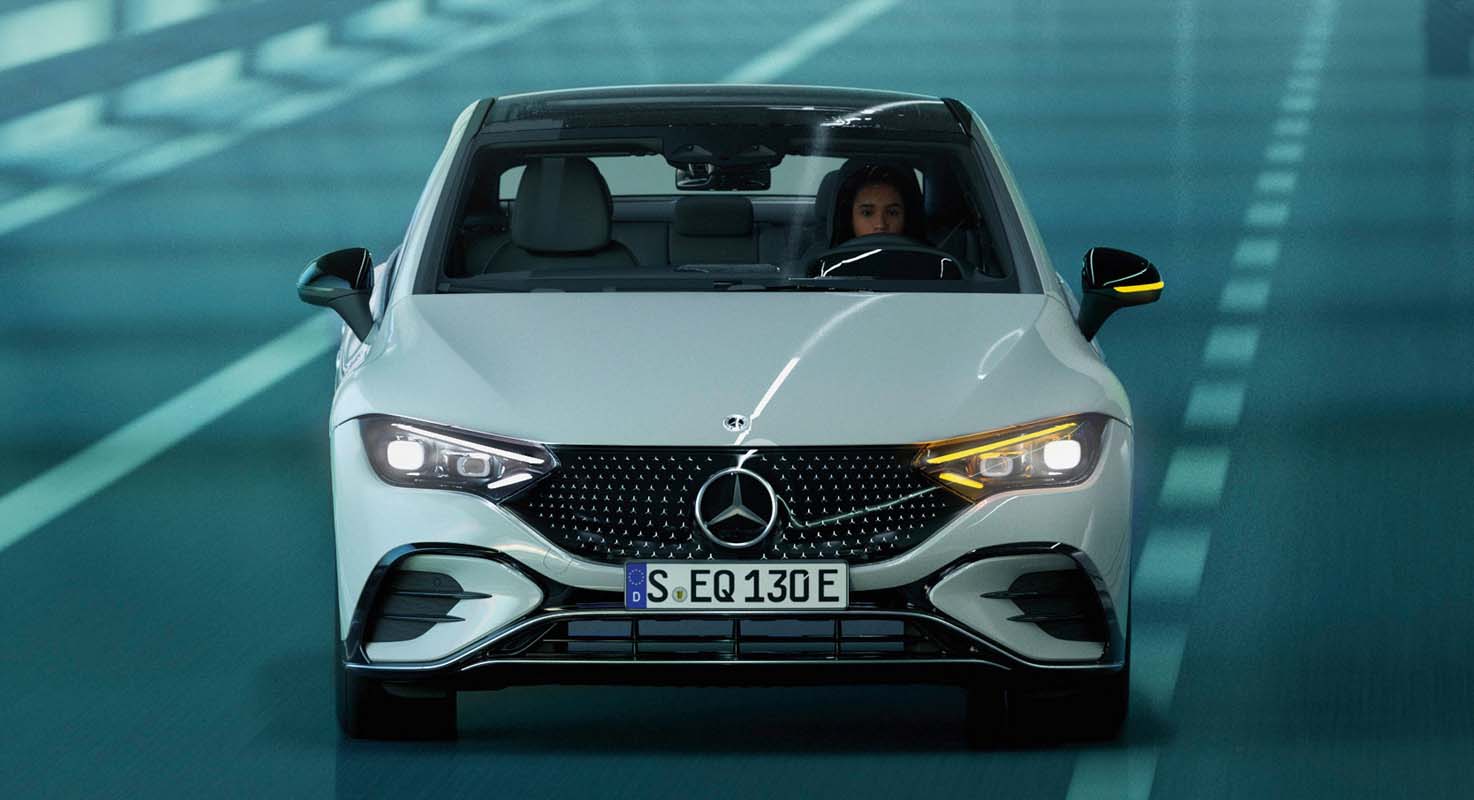
UX design: multiple display styles and modes to choose from
As with the EQS, the functional content and operating structure are adapted to electric driving. Visually, all graphics are designed in a new colour scheme of blue/orange throughout. The classic cockpit display of the two round dials has been reinterpreted with a digital lightsabre in a glass lens. All content relevant to driving can be accessed between the round dials.
The “sporty” display takes the form of a spatial power bar and conveys the relevant driving status (Drive, Accelerate, Charge) emotionally and impressively. The central object here is a “G-force puck”, which dynamically moves freely in space in line with the acceleration forces.
The appearance of the screens can be individualised with three display styles (Discreet, Sporty, Classic) and three modes (Navigation, Assistance, Service).
For a very calm interior impression, the Discreet mode familiar from the S-Class has been adapted. In the EQE, the content of the displays is reduced as much as possible and coordinated with the colour change of the ambient lighting in seven screen colour worlds. In “Assistance” mode, important events such as lane changes or target distance control as well as the infrastructure and detected other road users (cars, motorcycles, trucks) are displayed.
Electric drive
The models available on launch are the EQE 350 with 215 kW, and a second model. Further versions will follow. The battery has ten modules with a usable energy content of around 90 kWh, and the range of up to 660 km2 acc. to WLTP is absolutely suitable for long distance touring.
All EQE models have an electric drivetrain (eATS) on the rear axle. The later versions with 4MATIC also have an eATS on the front axle. In the 4MATIC models, the Torque Shift function ensures intelligent, continuously variable distribution of drive torque between the rear and front electric motors and thus the use of the most efficient eATS in each case. The modular powertrain concept ensures high overall performance and long range.
The electric motors on the front and rear axles are permanently excited synchronous motors (PSM). With the PSM, the rotor of the AC motor is fitted with permanent magnets and therefore does not need to be supplied with power. The magnets – and thus the rotor – follow the rotating alternating current field in the stator windings. In the EQE, Mercedes-Benz uses what is known as a pull-in winding for a particularly strong magnetic field. The engine is referred to as synchronous because the rotor turns at the same rate as the magnetic field of the stator. The frequency is adjusted in the power electronics converters to the speed requirements of the driver. The advantages of this design include high power density, high efficiency and high power constancy. The motor on the rear axle is particularly powerful due to its six-phase design: it has two windings with three phases each.
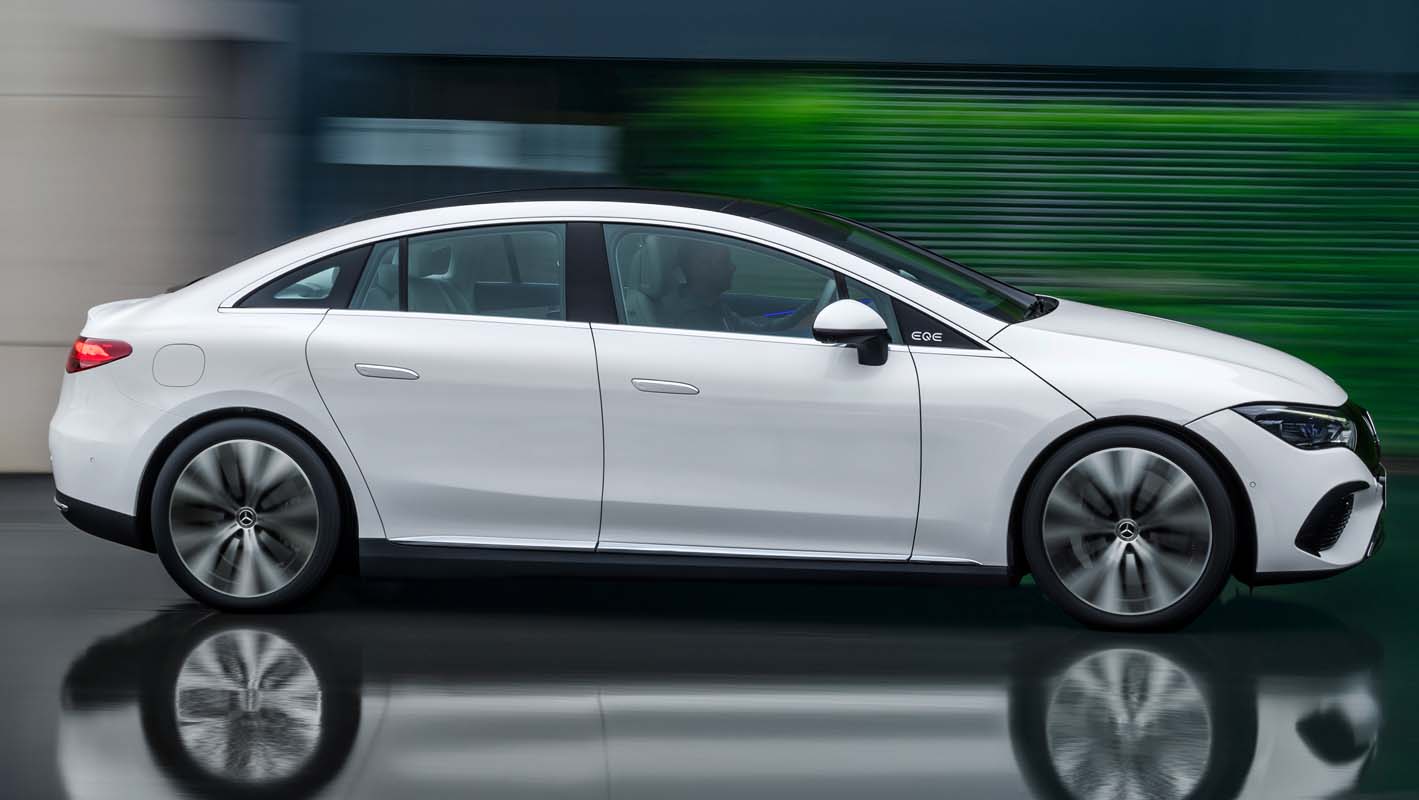
Cooling: sophisticated thermal concept for high load capacity
Consistently high performance and multiple accelerations without a drop in power characterise the EQE’s drive philosophy. This includes a sophisticated thermal concept with some special features. What is known as a water lance in the shaft of the rotor cools it from the inside. Other cooling elements in the cooling circuit are fins on the stator, a needle-shaped pin-fin structure on the inverter and a transmission oil cooler. This also brings more efficiency during cold driving, because the heat exchanger then serves to heat the transmission oil and thus reduces friction in the transmission.
Intelligent recuperation: one-pedal driving to a standstill
The EQE offers several variants of energy recovery by means of recuperation: in this process, the high-voltage battery is charged by converting the mechanical rotary motion into electrical energy during overrun or braking mode. The driver can manually select the deceleration in three stages (D+, D, D-) as well as the gliding function via shift paddles behind the steering wheel. Also available: DAuto.
ECO Assist also offers situation-optimised recuperation – deceleration is so strong or weak that it ultimately results in the most efficient driving style. Recuperative deceleration is also used as far as possible for vehicles detected ahead until they come to a standstill, for example at traffic lights. The driver does not need to press the brake pedal for this – literally one-pedal driving.
Noise and vibration comfort: conceptual advantage plus extensive measures
As a saloon with a boot lid, the EQE’s concept is well equipped to offer a high level of NVH comfort. Numerous measures contribute to this:
Even the design of the electric powertrains (eATS) takes noise and vibration comfort (NVH – Noise, Vibration, Harshness) into account. The magnets are arranged inside the rotors in an NVH-optimised way (known as ‘sheet metal cut’). This also reduces the use of rare earths. The shape of the winding, what is known as the stator tilt, also supports vibration comfort, especially at low speeds. In relation to the permanent magnets of the rotor, the coils of the stator are obliquely wound. Otherwise, what is known as cogging torque could occur. This would lead to slight but unpleasant vibrations when driving very slowly.
In addition, the eATS have a special foam mat all around as an NVH cover. The inverter cover has a sandwich construction of three metal and plastic layers. The eATS are doubly decoupled from the body via elastomeric bearings: at the front axle opposite a supporting frame and this against the body, at the rear axle with a subframe.
Highly effective spring/mass components provide continuous sound insulation from the crossmember under the windscreen to the floor of the boot. Acoustic foams are inserted into many carriers during body-in-white construction.
The electric refrigerant compressor has an NVH cover as encapsulation. In the rear-wheel-drive EQE, it is also soft-suspended, while in the 4MATIC models it is bolted directly to the front eATS. The operating strategy of the refrigerant compressor was designed for the highest possible noise and vibration comfort. Certain rpm ranges at which disturbing resonances may be audible when stationary or in a traffic jam are avoided or quickly passed through.
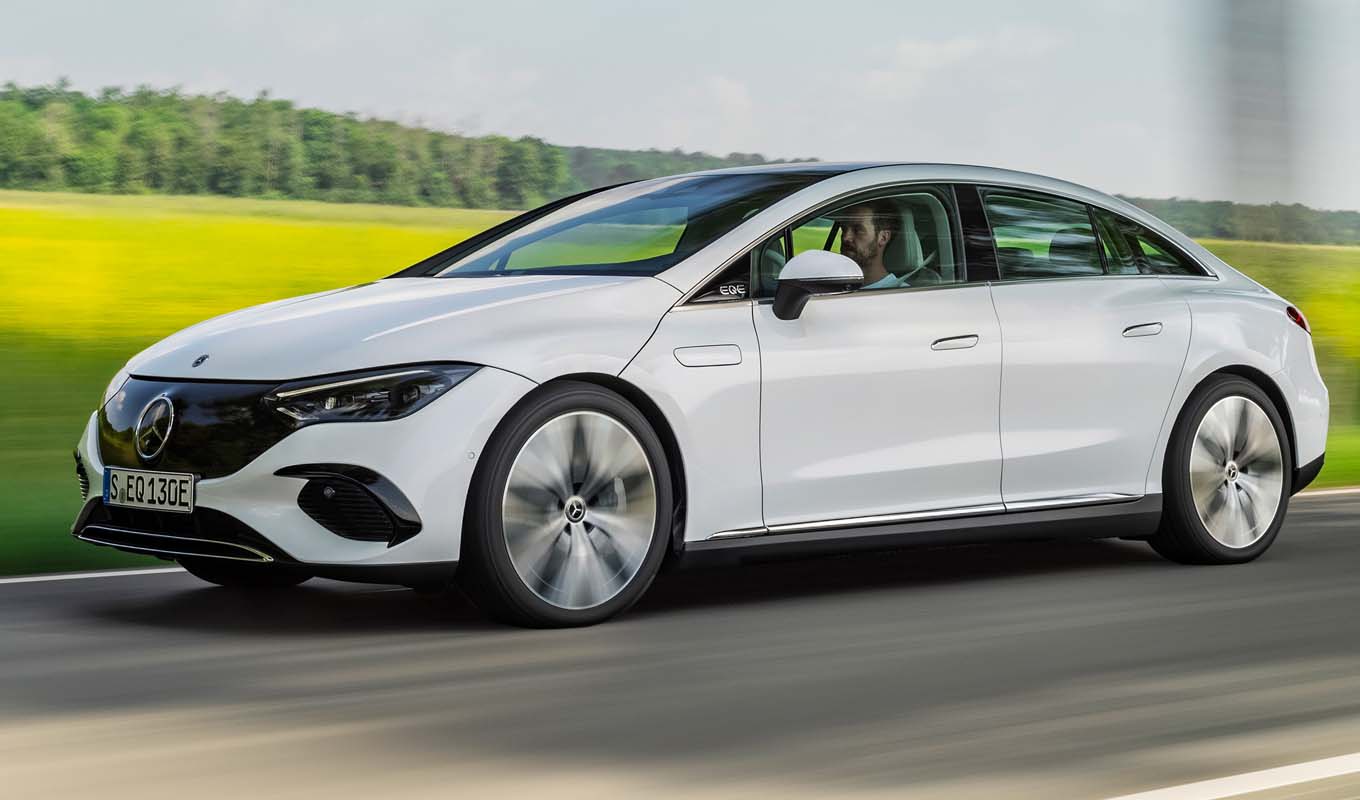
The suspension
The suspension of the new EQE, with four-link front suspension and multilink rear suspension, is closely related in design to the new S-Class. Rear-axle steering with a steering angle of up to 10° is available as an option for plenty of manoeuvrability in town and agility out of town. Optionally, the EQE is also available with AIRMATIC air suspension with ADS+ adaptive damping system.
The EQE has the proven four-link front suspension. Its multilink rear suspension is designed to integrate the rear-axle steering. The suspension subframe carriers and the elastomeric bearings of the rear axle struts were improved in terms of NVH and driving characteristics by conducting extensive simulations and driving tests.
The optional AIRMATIC air suspension responds particularly sensitively. It combines air suspension bellows with adaptive ADS+ dampers whose characteristics can be fully automatically varied at each individual wheel, in both the compression and rebound stages. While driving, a sophisticated sensor system and algorithms set the dampers according to the quality of the road to ensure that, for example, driving over a bump with just one wheel is not transmitted to the entire axle and the interior. Spring and damper are combined in one strut on the front axle.
This level control is part of AIRMATIC. It keeps the ground clearance constant irrespective of the vehicle load, but also makes changes when needed. By way of example, in the SPORT program the vehicle body is lowered by 20 mm at high speeds above 120 km/h to reduce aerodynamic drag and increase handling stability. If the vehicle drops below 80 km/h, the body level returns to the initial position. Up to 40 km/h the body can be raised by 25 mm at the touch of a button, above 50 km/h it is automatically lowered back to normal level.
As manoeuvrable as a compact car: both axles can do the steering
Thanks to rear-axle steering (optional extra), the EQE feels as manoeuvrable as a compact car in the city. The steering angle at the rear axle is up to ten degrees. The turning circle is reduced from 12.5 to 10.7 metres with rear-axle steering.
The interaction between front-axle and rear-axle steering has been designed to achieve agile response with low steering effort in city and country road driving, but at the same time very high stability. This results in e.g. small side-slip angles and a high level of yaw suppression. At high speeds the focus is more on stability, though without compromising precision and responsiveness. This added value is achieved by integrated actuation of the steering and brakes (ESP®), and considerably improves handling safety as a result.
Depending on the tyres selected, customers can choose between two versions of the optional rear-axle steering with a maximum steering angle of 4.5° and 10°.
DYNAMIC SELECT: the EQE drives the way the driver wants it to drive
The driver can individually modify the characteristics of the powertrain, ESP®, suspension and steering. The selection is made using a control at the lower end of the central display. The default setting is the COMFORT drive program, with SPORT, ECO and INDIVIDUAL available as alternatives. The selection is acknowledged by acoustic and visual feedback. The desired drive program is shown as the status and depicted in the central display.
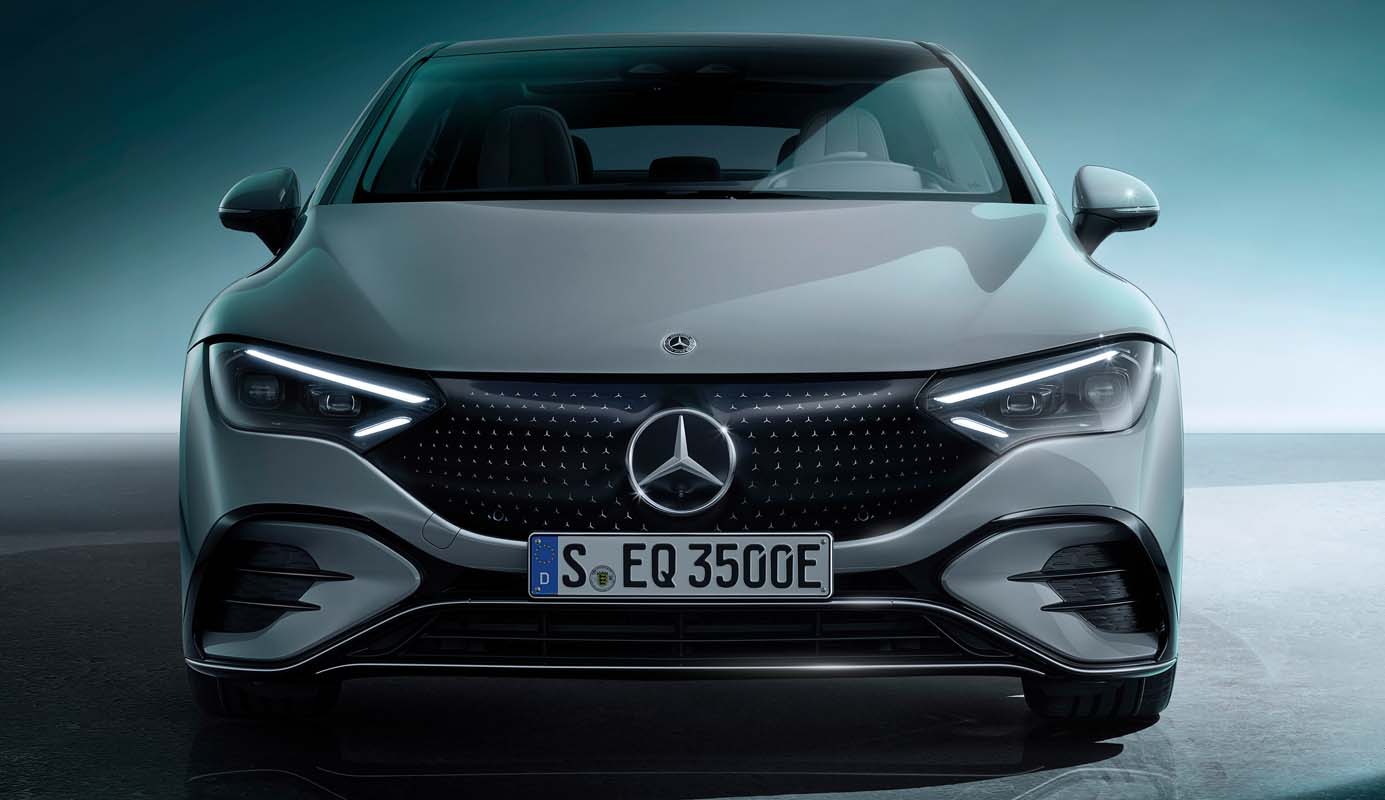
MBUX Hyperscreen
The MBUX Hyperscreen is the absolute highlight in the interior. This large, curved screen unit sweeps almost from A-pillar to A-pillar. Three screens sit under a common bonded glass cover and visually merge into one display. In addition to the zero-layer design, the MBUX Hyperscreen offers intuitive touch operation with haptic feedback and force feedback. The scratch-resistant glass is coated to make cleaning easier.
With the MBUX Hyperscreen (optional extra), three displays merge almost seamlessly into one another to create an impressive screen band over 141 centimetres wide: driver display (screen diagonal: 12.3-inch), central display (17.7-inch) and front passenger display (12.3-inch) appear as one visual unit.
The selected display style is shown uniformly on all screens; and the brightness is homogeneously adapted to the lighting conditions in the interior. The control panels for the automatic climate control system are located in the lower area of the central display. These remain permanently displayed so that the driver and front passenger can directly adjust the temperature and ventilation.
For particularly brilliant display quality OLED technology is used for the central and front passenger displays. This is where the individual image points are self-luminous; non-controlled image pixels remain switched off, which means that they appear deep black. The active OLED pixels, on the other hand, shine with a high colour brilliance, which also means high contrast values – irrespective of the perspective and the light conditions.
The central and front passenger displays also provide haptic feedback. When a finger touches certain spots on the touchscreen, actuators (eight in the central display, four in the front passenger display) trigger a perceptible vibration of the glass cover. The user thus feels pulses on the smooth surface, which give the impression of a mechanical switch. Another operating aid known from high-quality consumer electronics products is the force feedback of both displays. For this purpose, a metallised foam is integrated into the device as a force sensor. Different levels of pressure on the glass change the response. For example, MBUX then jumps to another menu level.
The 12.3-inch OLED display for the front passenger gives them their own display and control area, making journeys more enjoyable and entertaining. The 12.3-inch OLED display for the front passenger gives them their own display and control area. In Europe, the passenger is allowed to watch dynamic content such as videos, TV or internet even when on the move. This is because Mercedes-EQ uses an intelligent, camera-based blocking logic: if the camera detects that the driver is looking at the front passenger display, this is automatically dimmed for certain content. The driver then cannot look at them while driving. If the front passenger seat is not occupied, the screen becomes a digital decorative image. The customer can choose from various decorative images, including a starry sky, i.e. the Mercedes-Benz pattern.
The curved glass cover is made of particularly scratch-resistant aluminium silicate glass and is coated to make cleaning easier. For example, fingerprints can be easily removed with a microfibre cloth.
Ergonomic, sophisticated, robust: the development
During the development of the MBUX Hyperscreen, Mercedes-Benz engineers carried out extensive ergonomics studies with visual beams. The result is an optimised alignment of the MBUX Hyperscreen to reduce reflections caused by the curvature of the glass cover. In addition, the upper part of the windscreen is shaded by a tinted strip.
Other details designed with the hallmark Mercedes-Benz meticulousness include the brightness of all three screens, which is adjusted to the respective ambient conditions. A light sensor above the central display is used to determine the illumination level in the driver and front passenger areas. In addition, the camera integrated in the driver display measures the ambient brightness. Both the brightness and the image content of the displays are then adjusted. At the same time, this algorithm is less susceptible to scattered light and thus to misinterpretation of the measurement system.
Tolerance to high temperature differences, immunity to vibrations and protection against dust are among the tough automotive requirements for which the entire system has been designed. Age-related burn-in effects of OLED displays are countered with the help of various technical solutions. The ageing process of each individual pixel is permanently monitored and an automatic adjustment is carried out in the background to compensate for it. In addition, the displayed image information rotates slightly and imperceptibly counter-clockwise to reduce permanent strain.
Curved, bonded and printed: the production
The large glass cover is curved three-dimensionally using the moulding process. This hot forming of glass at process temperatures of approx. 650°C places the highest demands on mould making and process control and is used in the production of optical glass for camera lenses and smartphone glass covers. With the MBUX Hyperscreen, this process enables a distortion-free view of the displays across the entire width of the vehicle, regardless of the radius of the glass cover.
All displays are transparently bonded to the glass cover for a uniform refractive index curve to avoid reflections as much as possible. The central and front passenger displays are optically connected to the glass cover under vacuum. This so-called dry-bonding process uses an adhesive material similar to double-sided adhesive tape. The LCD driver display, which is flat owing to its design, uses a wet bonding process in which the adhesive material is liquid to compensate for the radius of the glass cover.
The black areas between the screens are printed onto the glass cover from behind using a screen printing process specially adapted to the curvature. The colour of the black print was adapted to the reflection behaviour of the OLED displays in order to achieve a homogeneous overall impression in a wide variety of lighting situations. For certain important warning lights to the right and left of the driver display, a mask is used during the screen printing process to leave out the corresponding symbol.
The MBUX Hyperscreen is surrounded by a continuous front frame in plastic. This visible part is painted in “Silver Shadow” using an extensive three-coating process. This paint system achieves an especially high-quality surface impression through extremely thin intermediate coats. The integrated ambient lighting included in the lower section of the MBUX Hyperscreen appears to make the display unit hover on the instrument panel.
Extensive precautions: the safety measures
The MBUX Hyperscreen is bolted directly to the cockpit crossmember for stability: the connection to a stabilising magnesium support as the structural component of the MBUX Hyperscreen is made via aluminium brackets. Their honeycomb structure allows them to deform in a controlled manner in a crash. For reasons of side impact protection, the glass cover also does not extend all the way to the doors. In the event of a severe side impact, there are also predetermined breaking points behind the side air vents.
